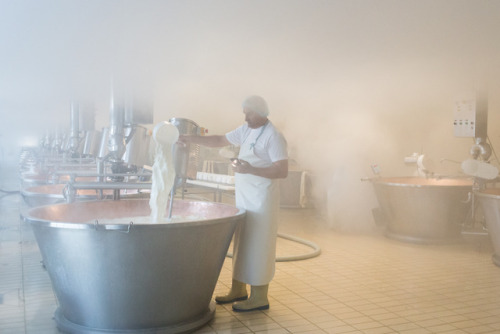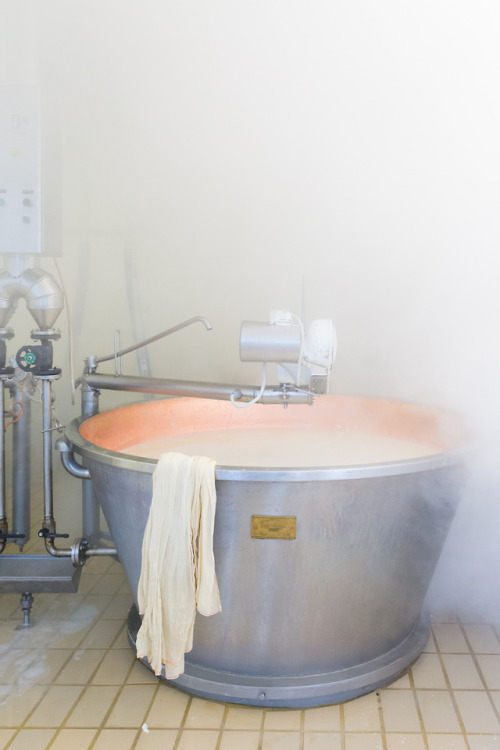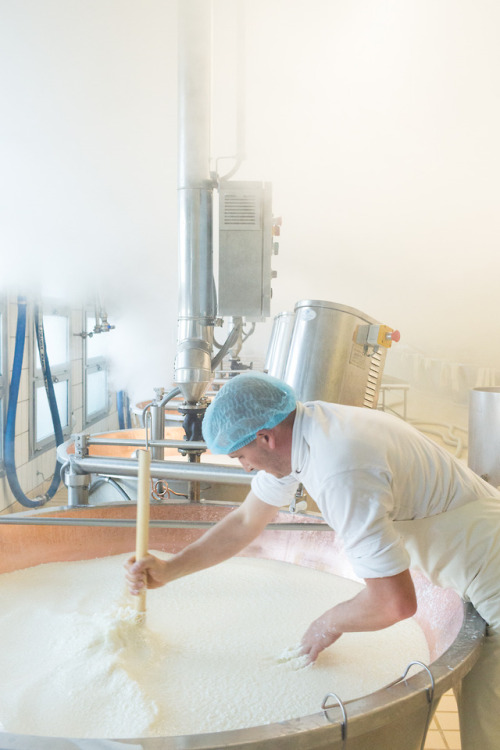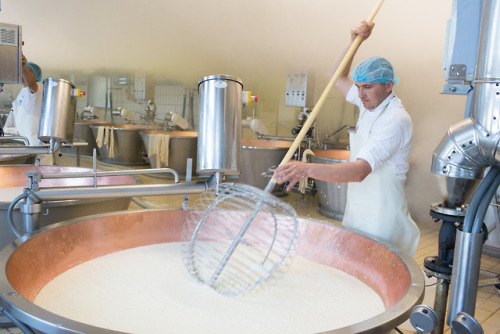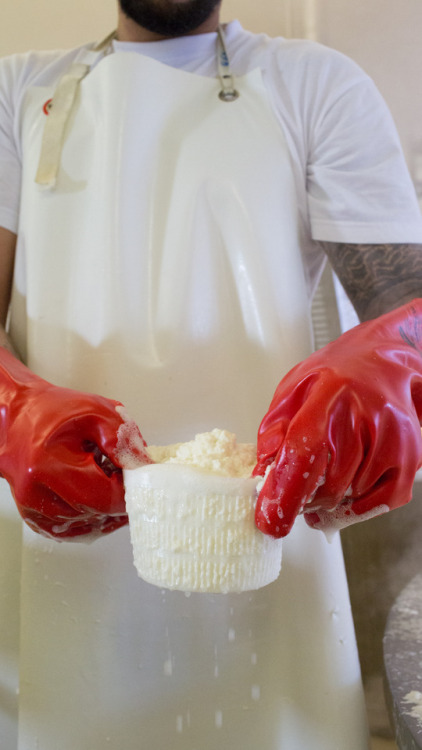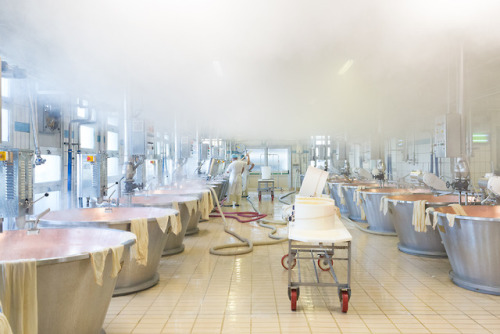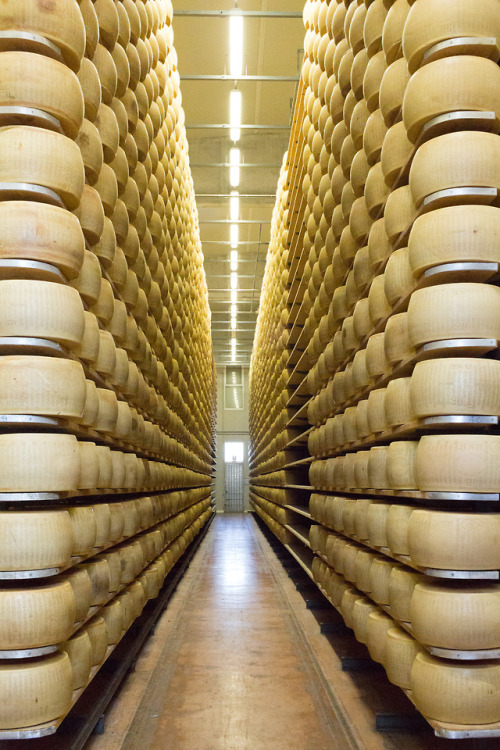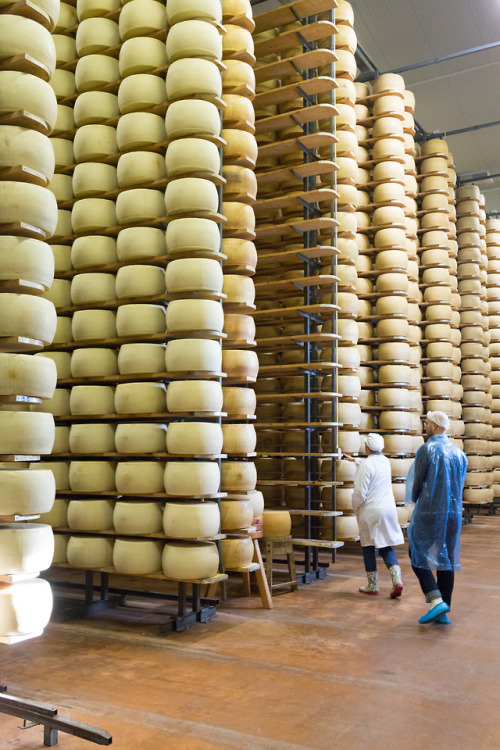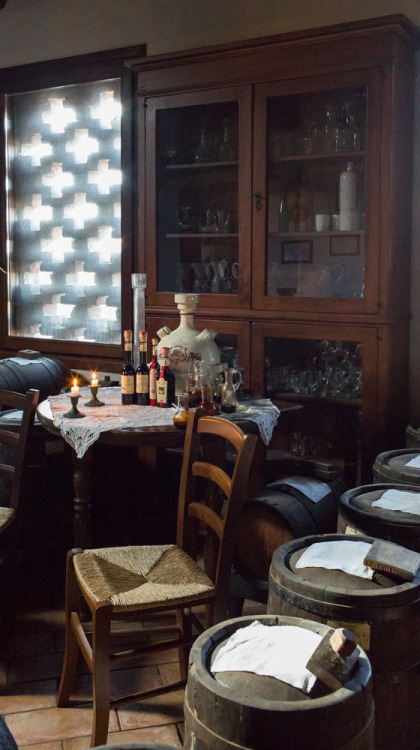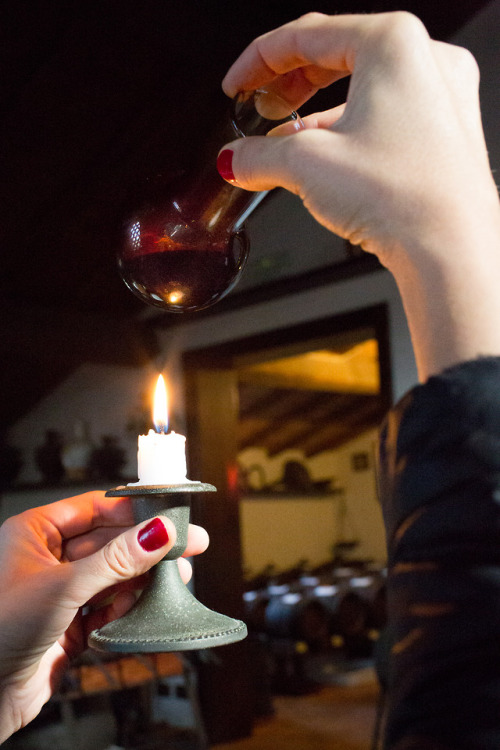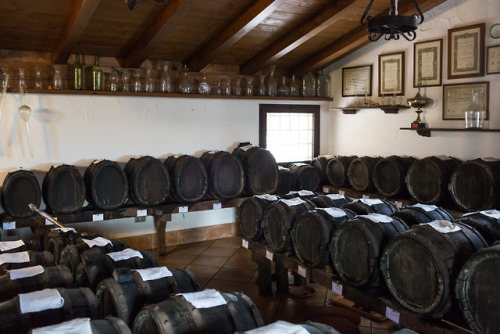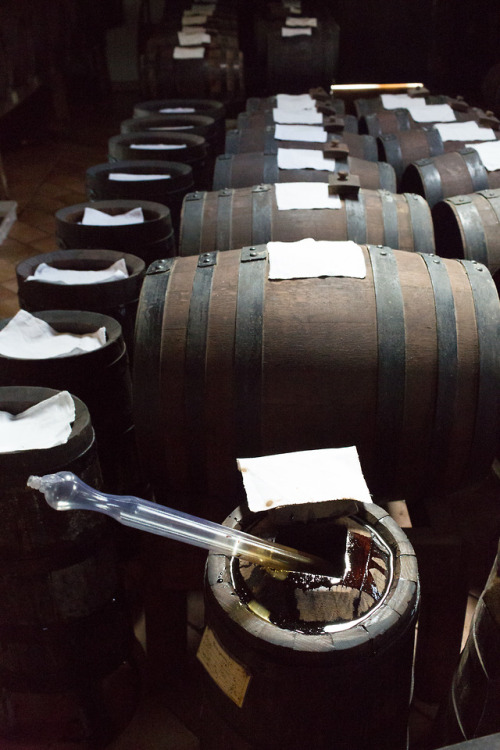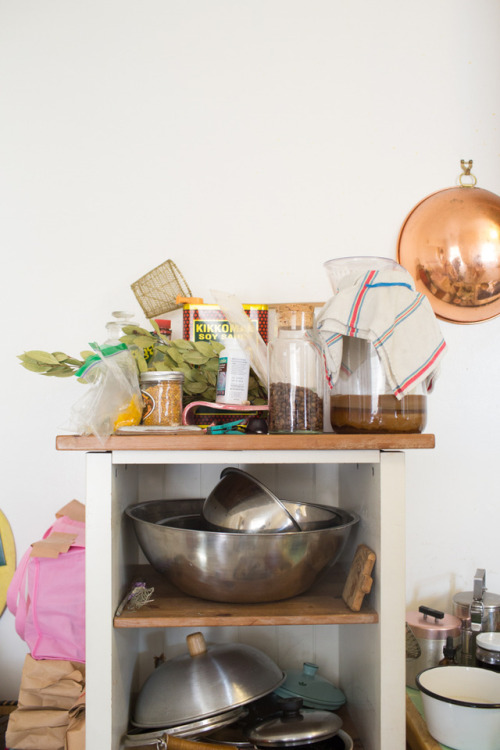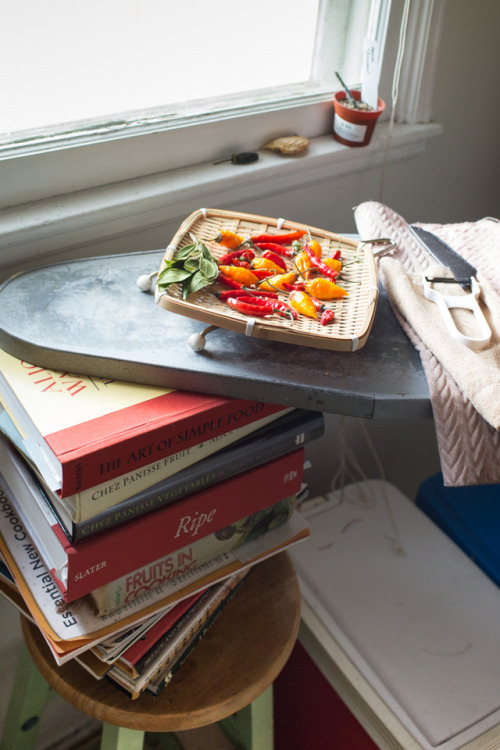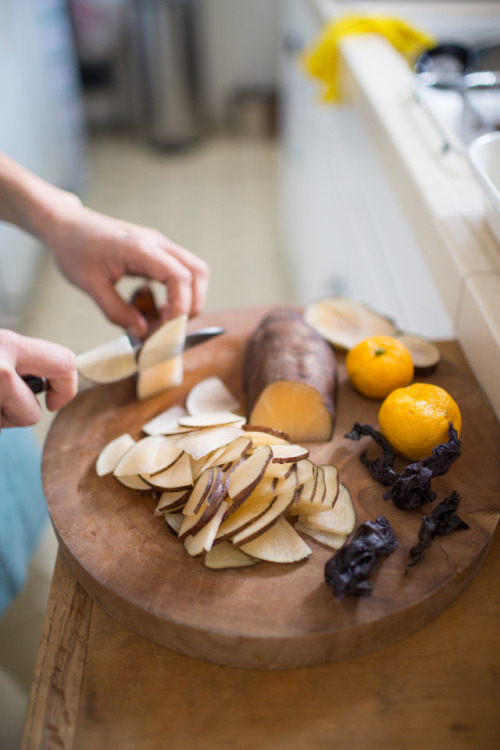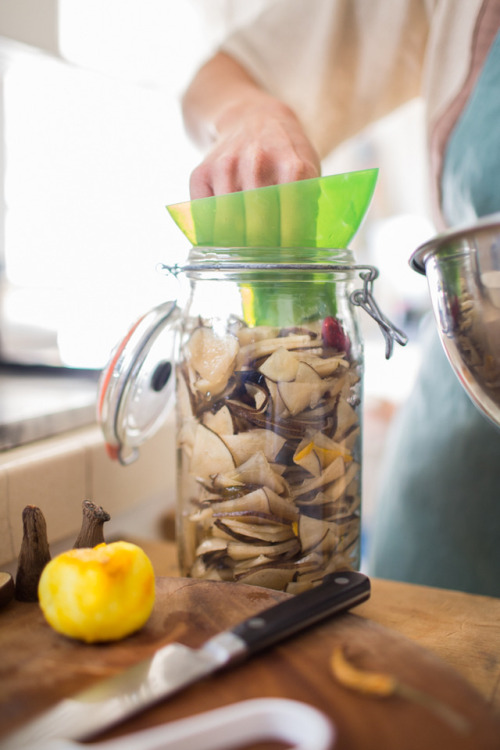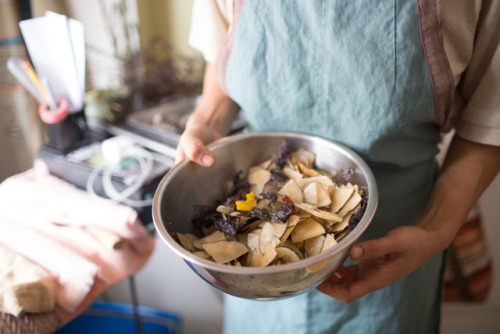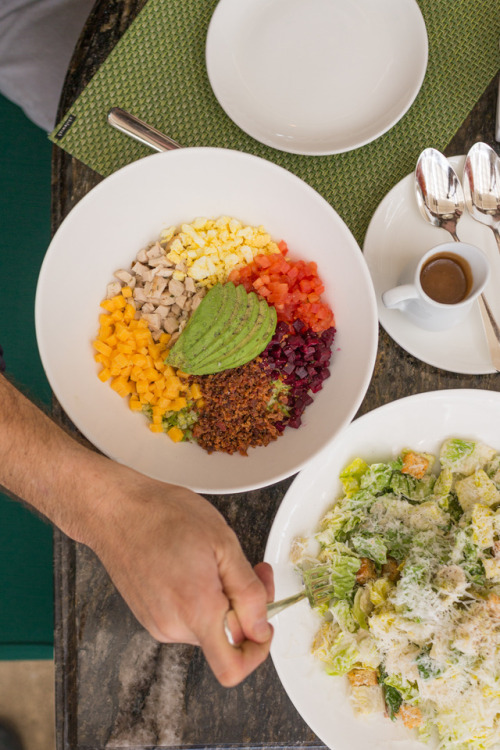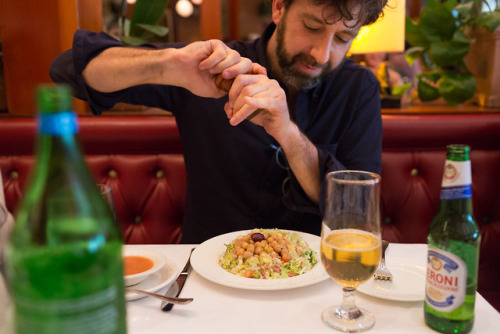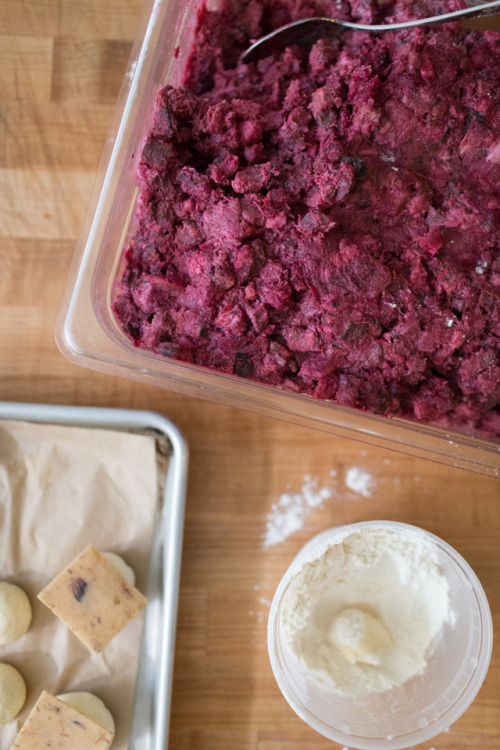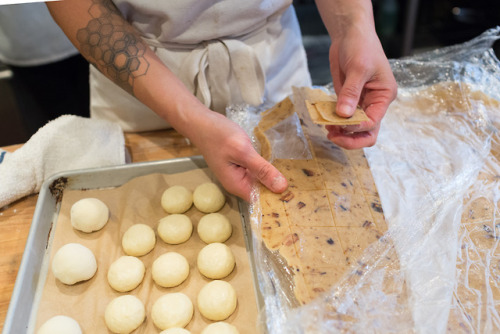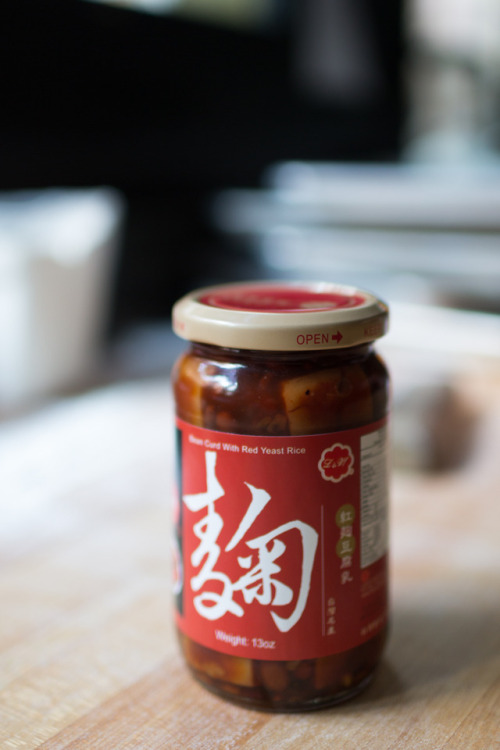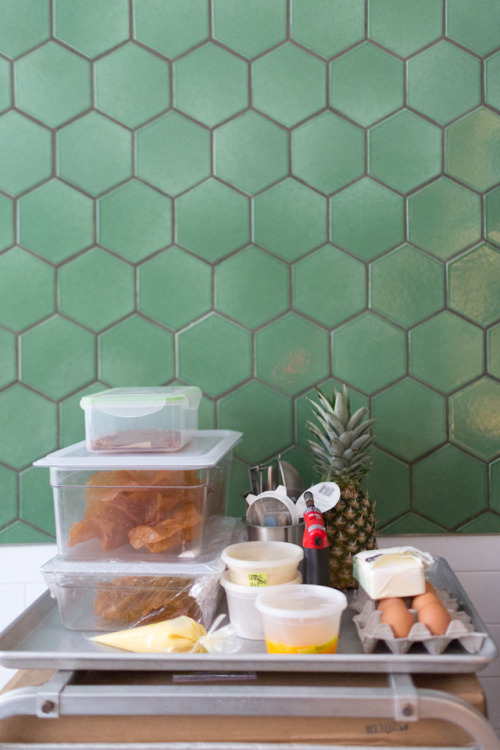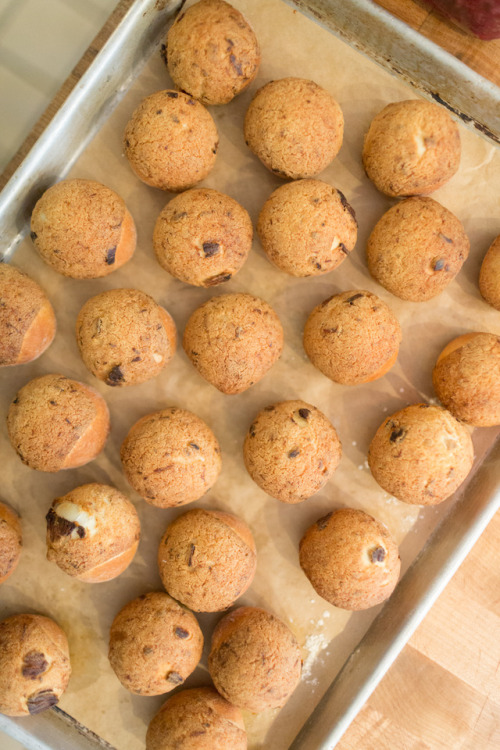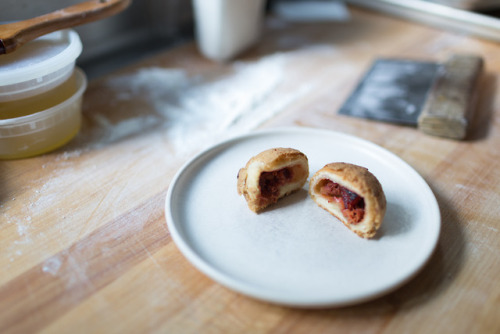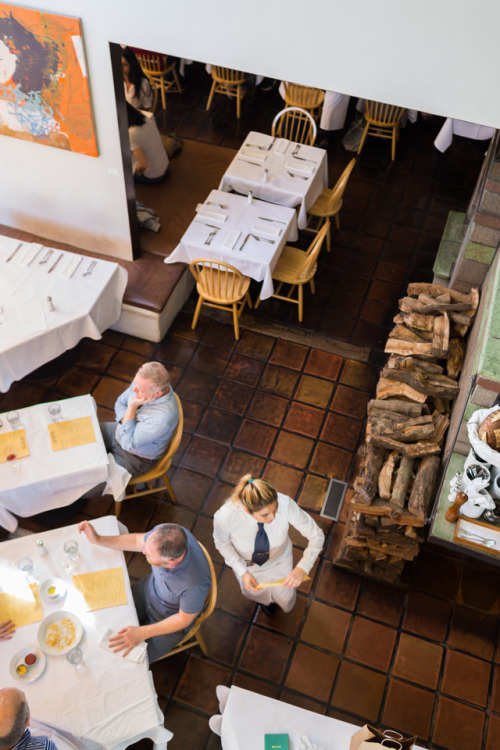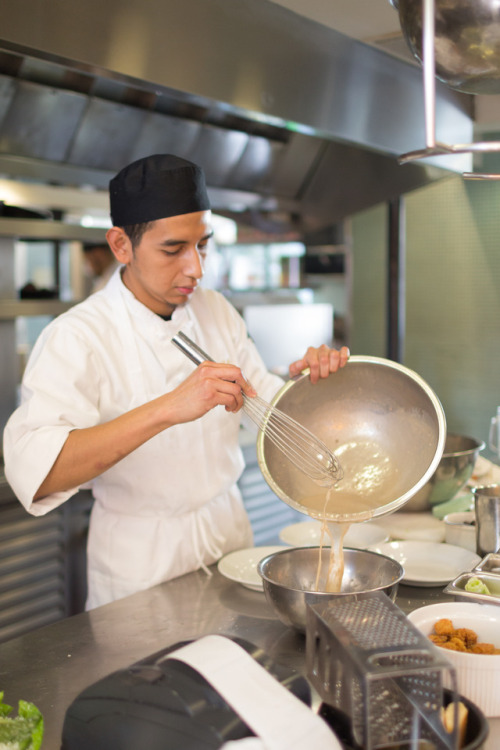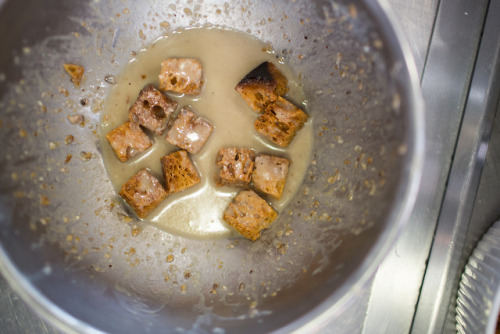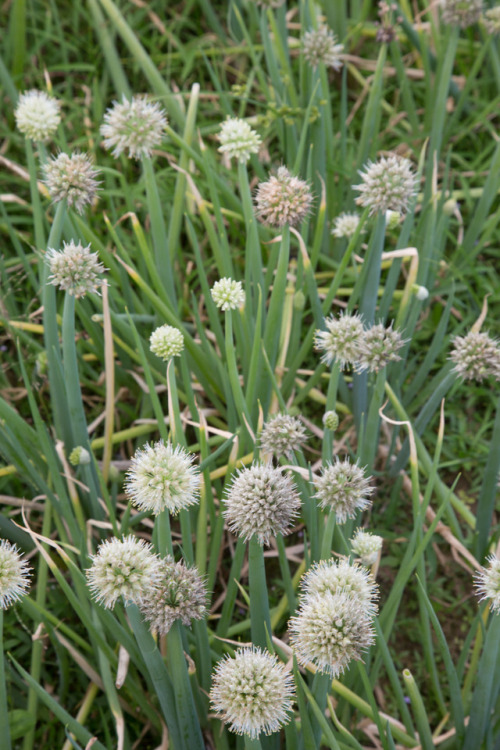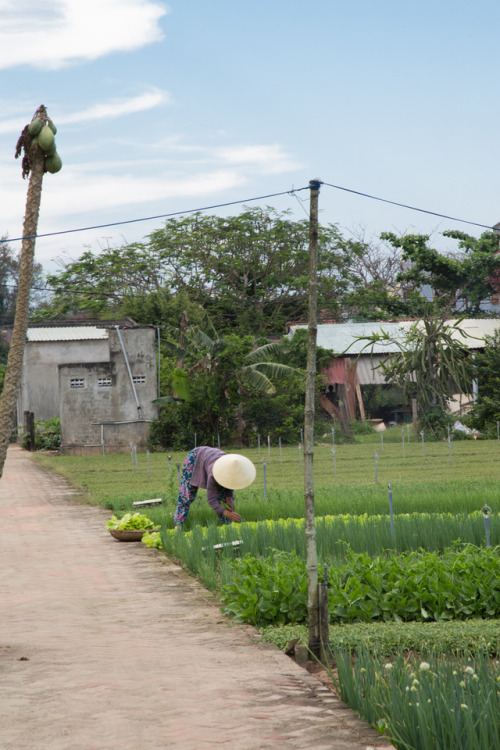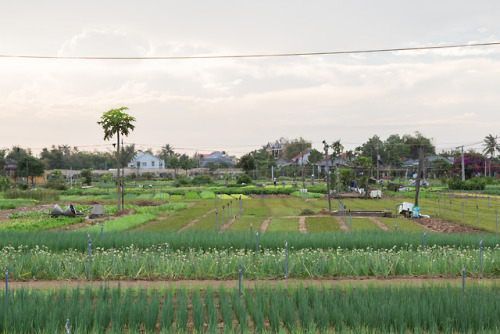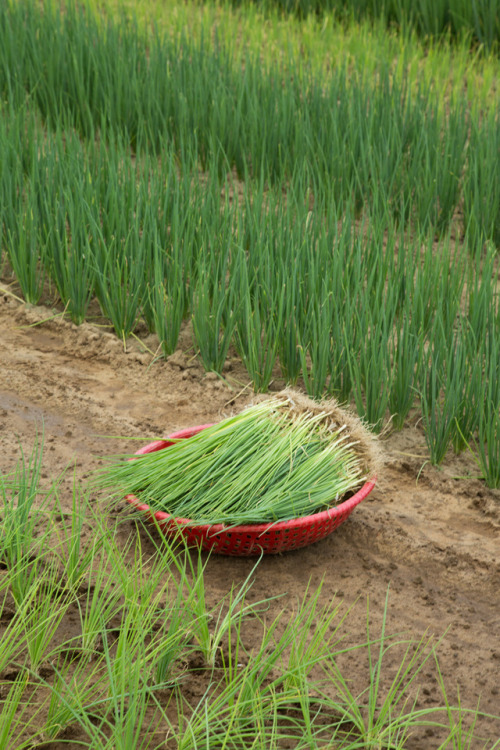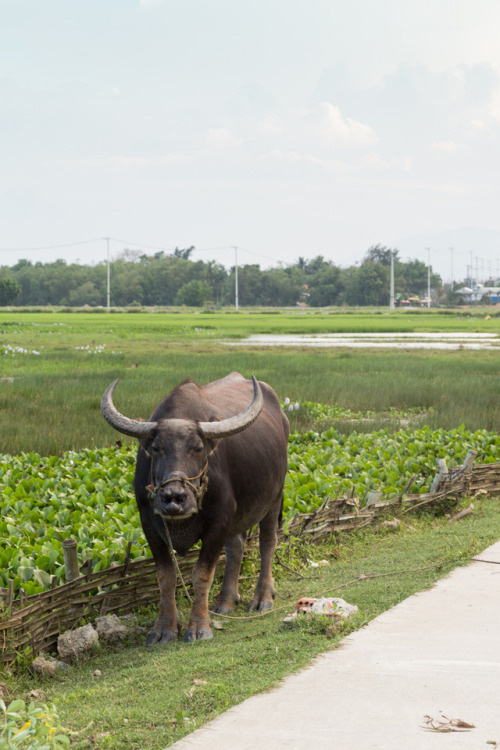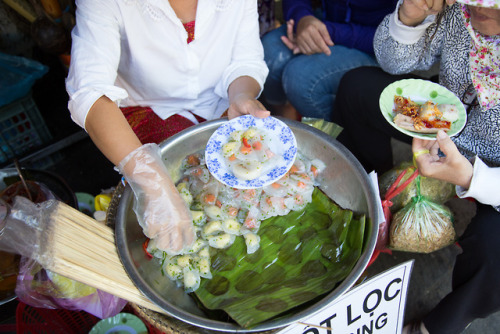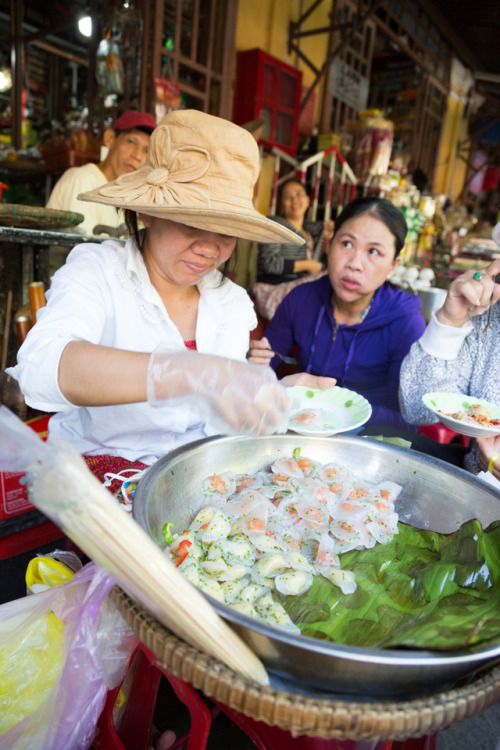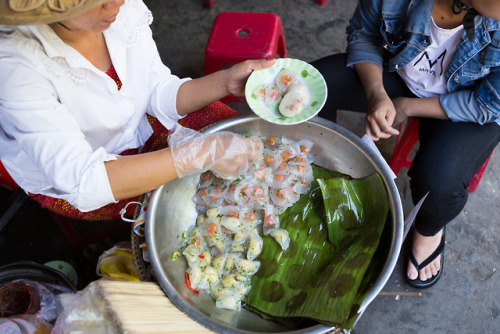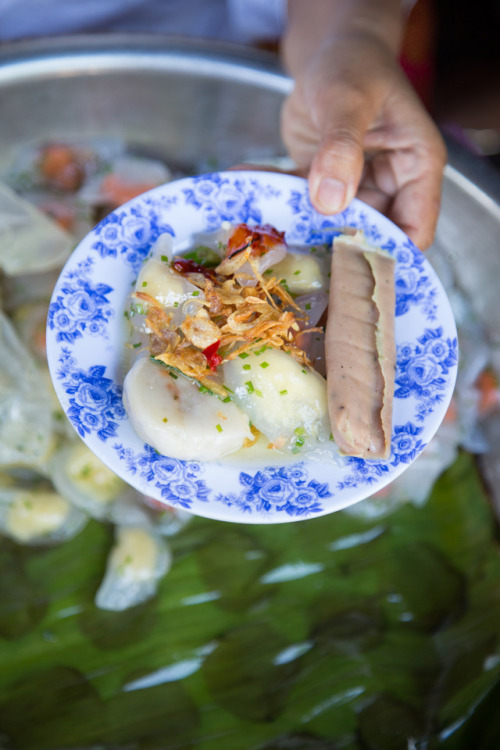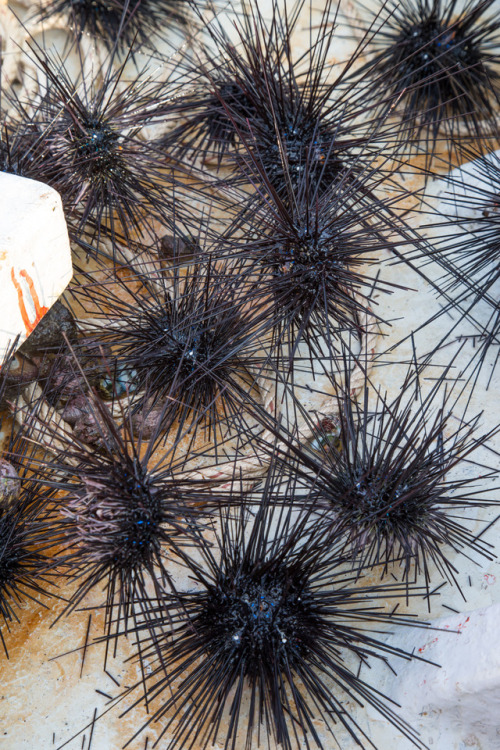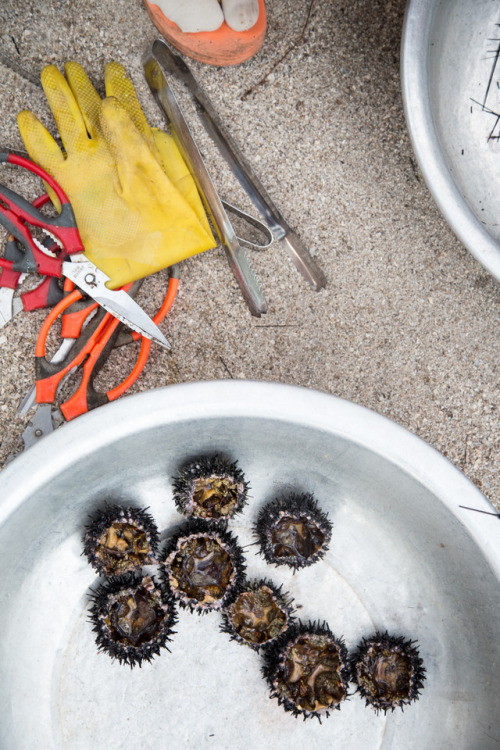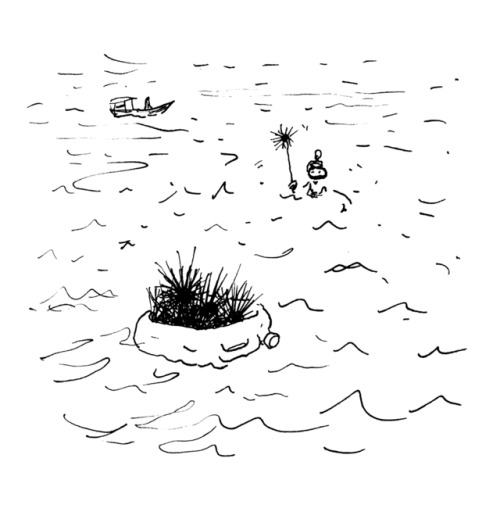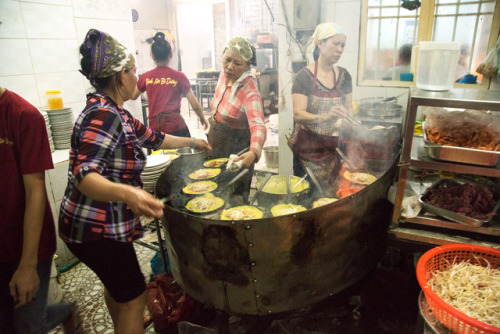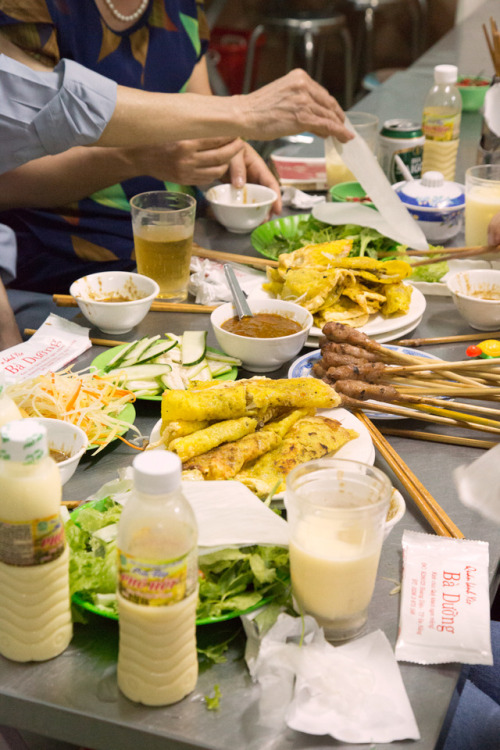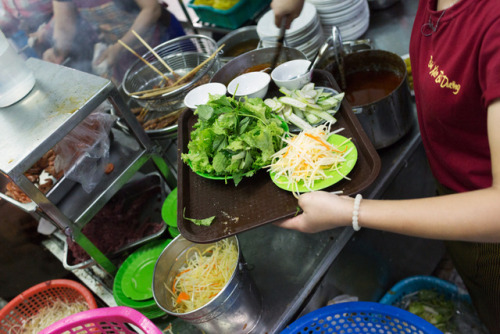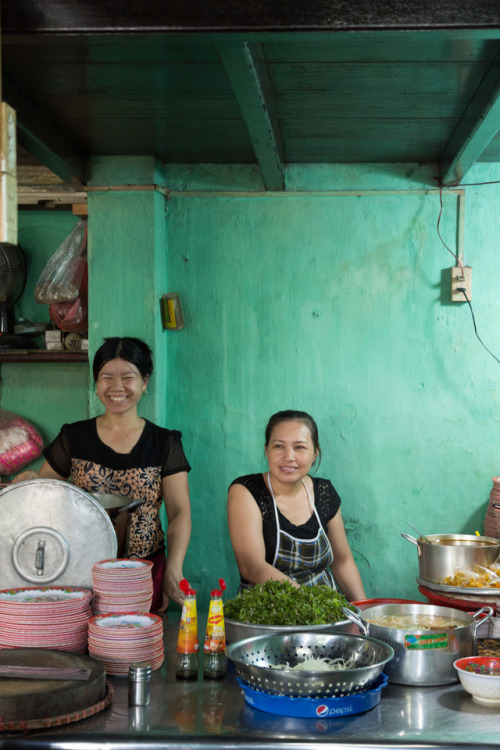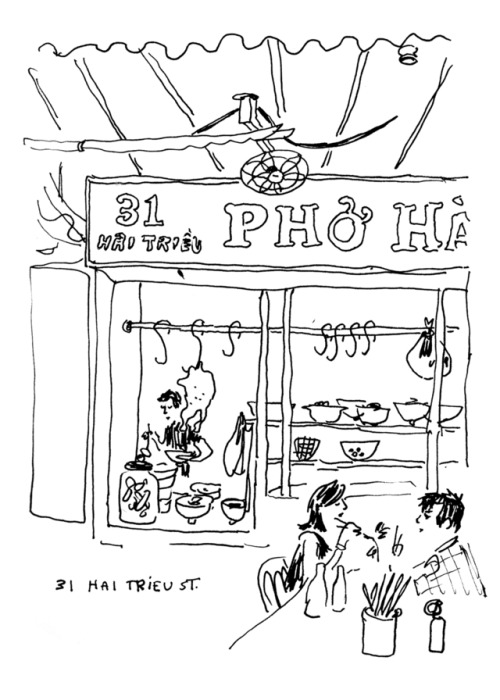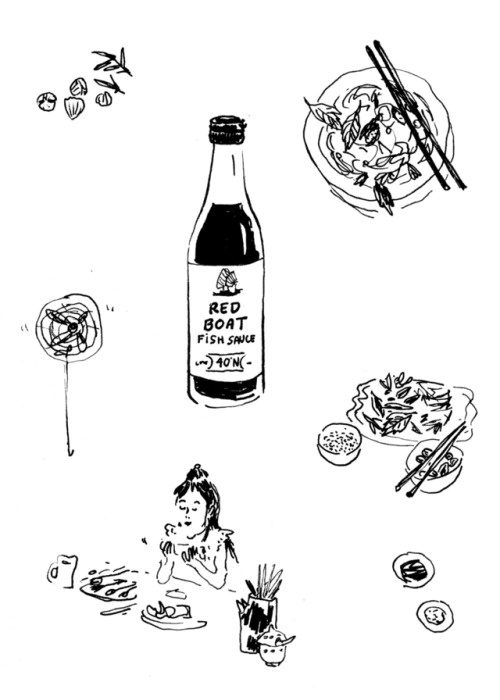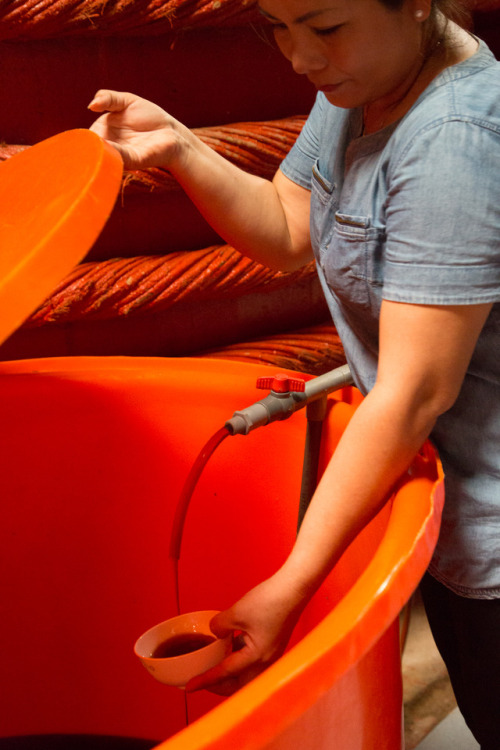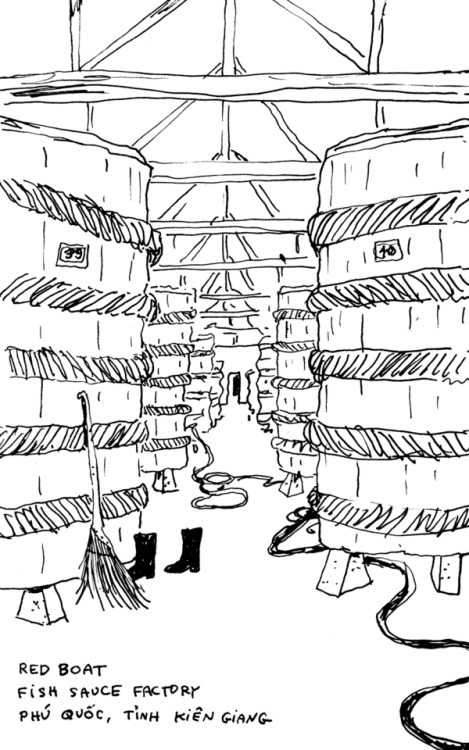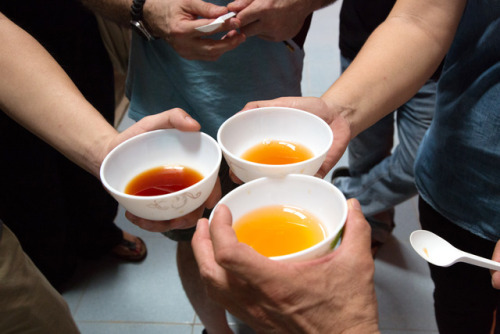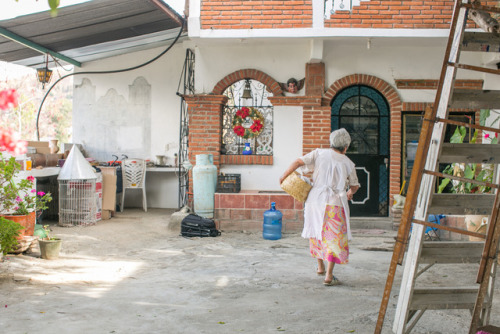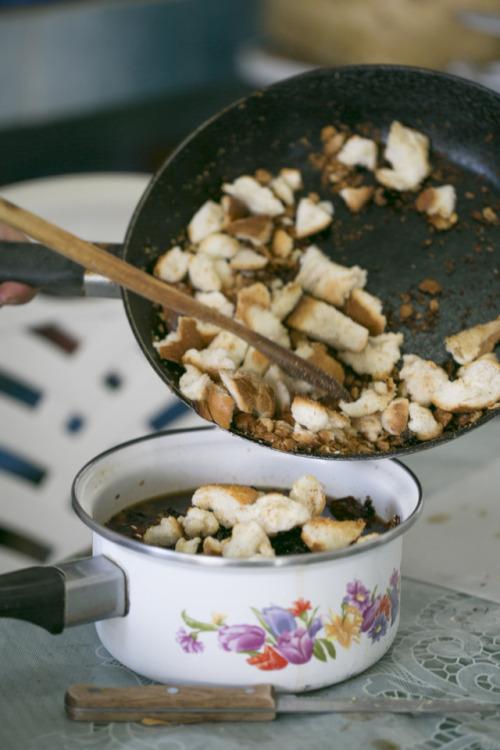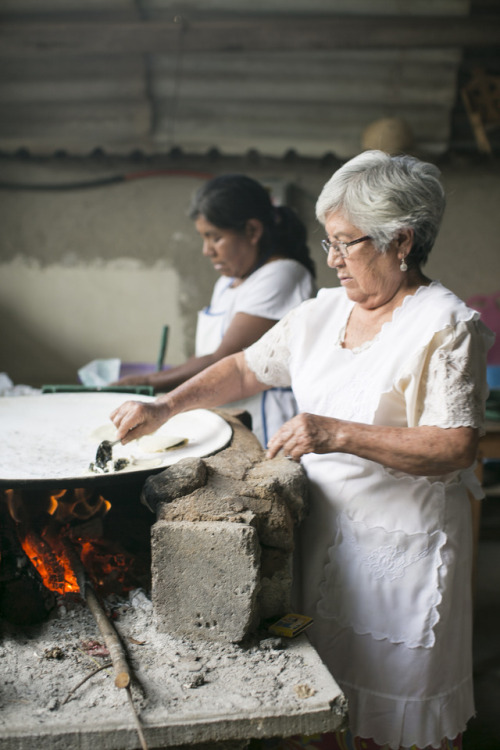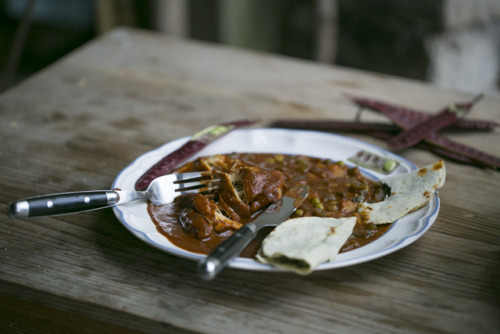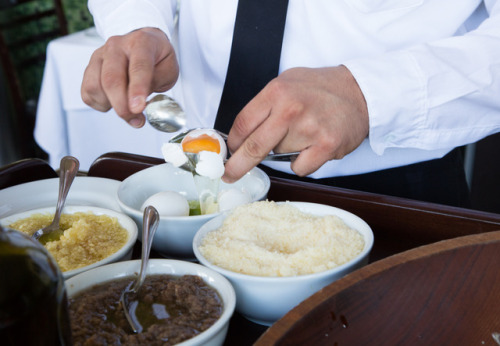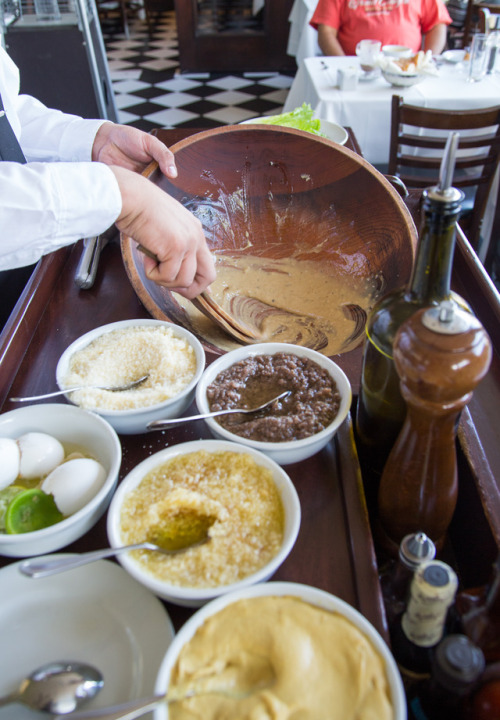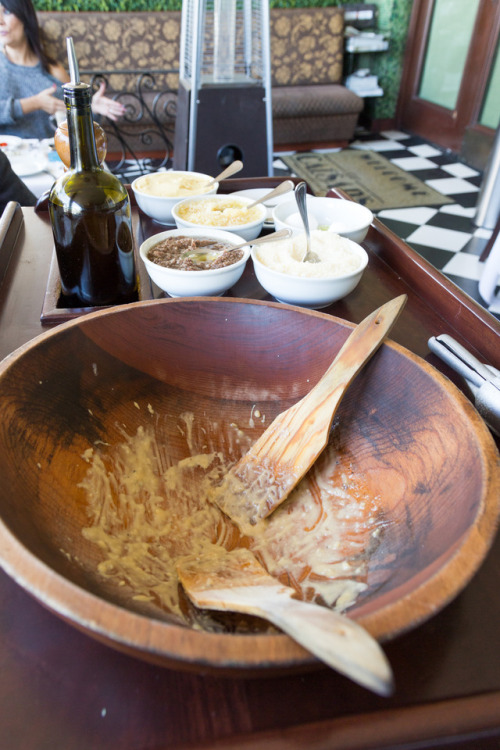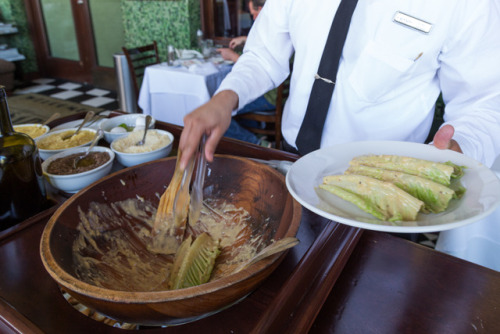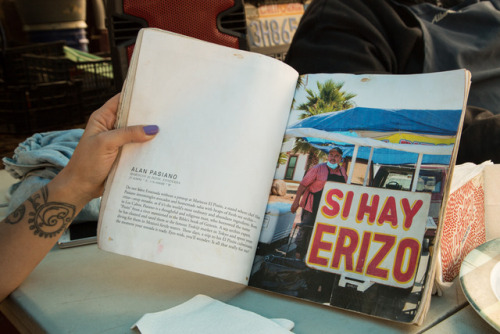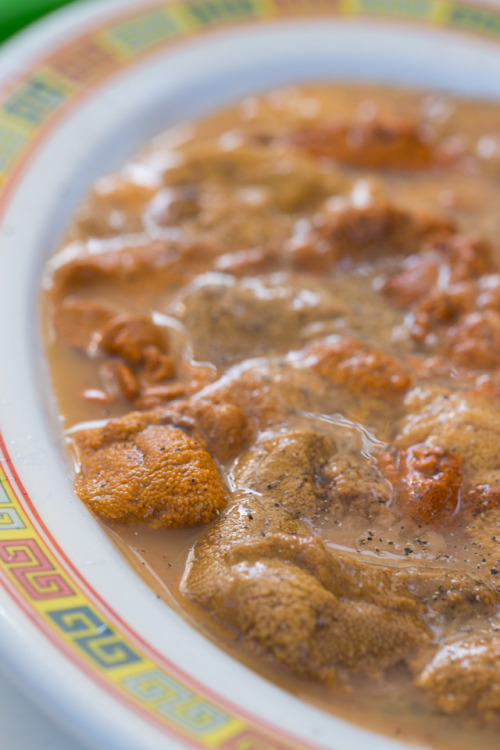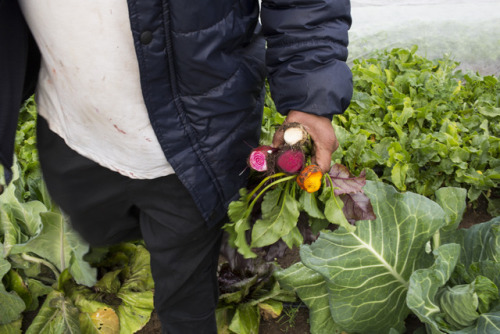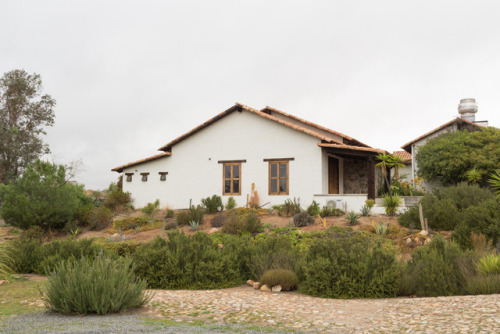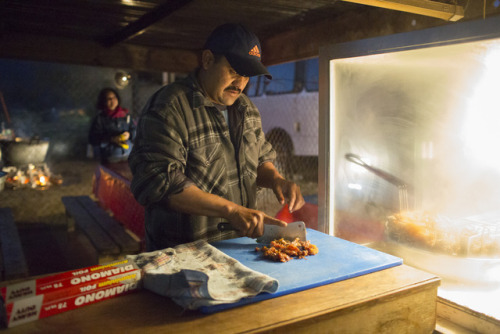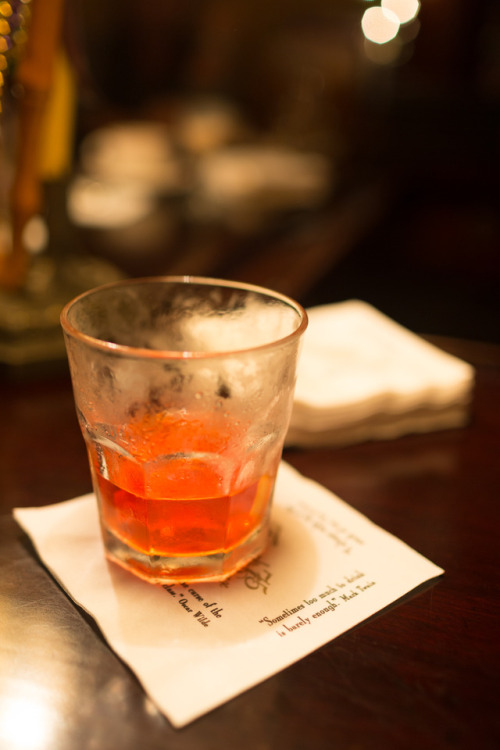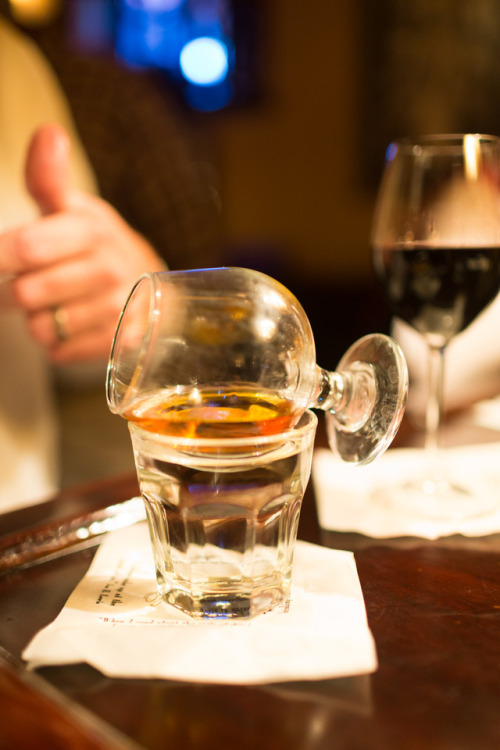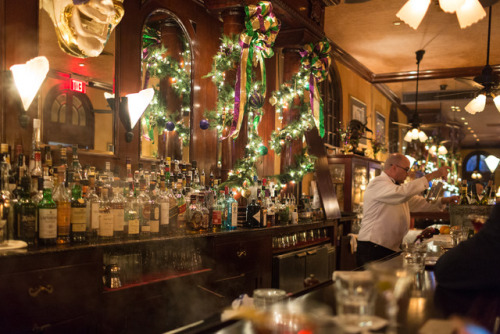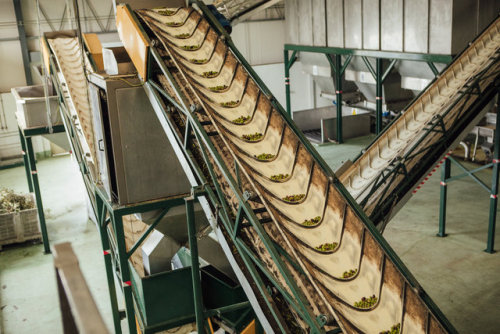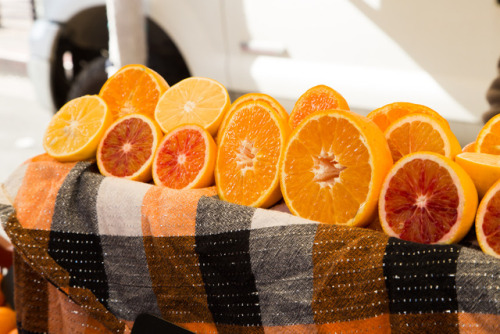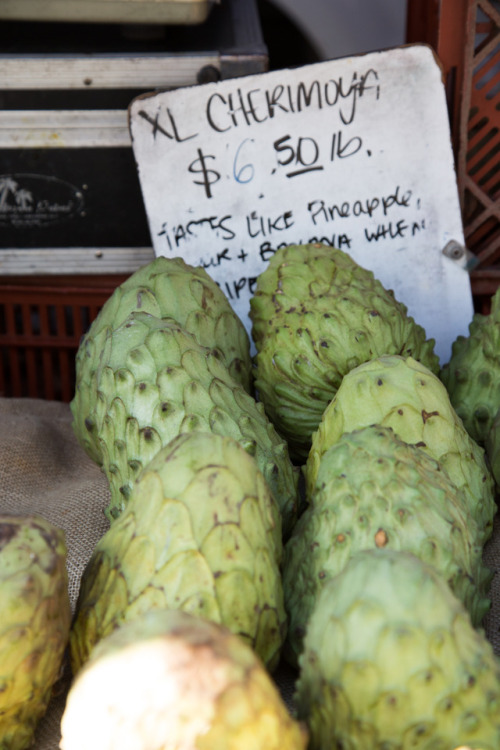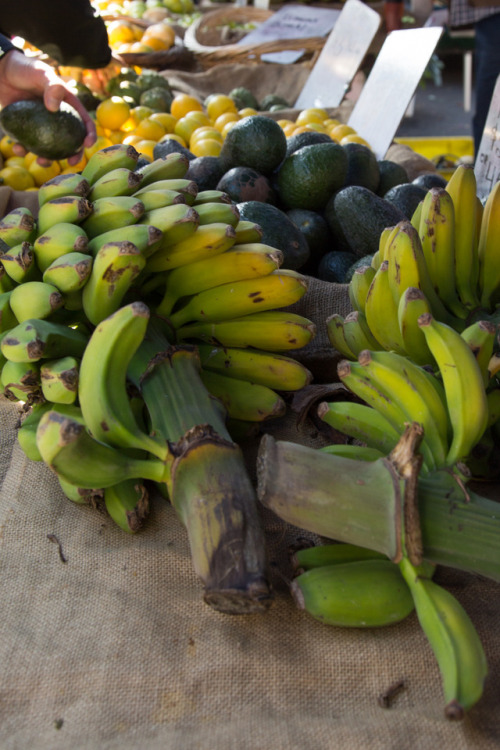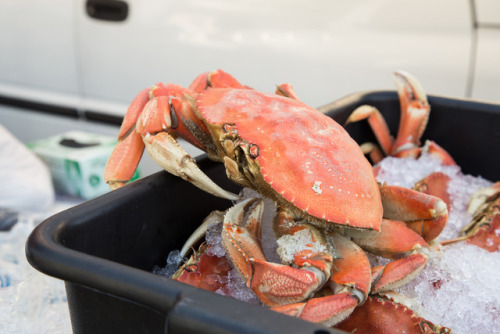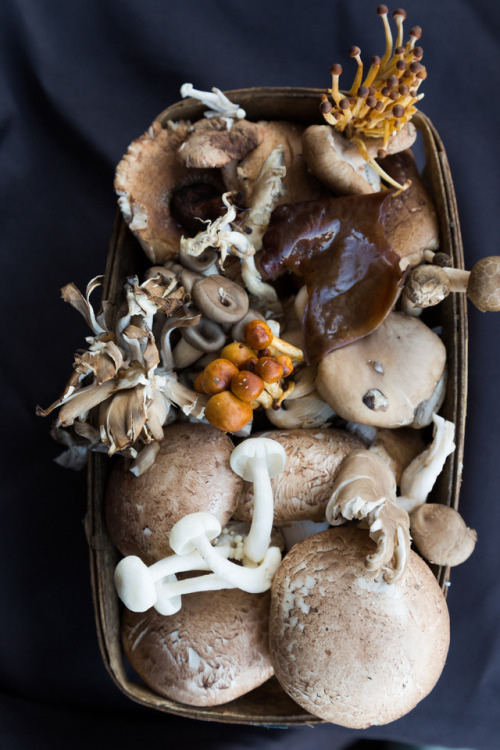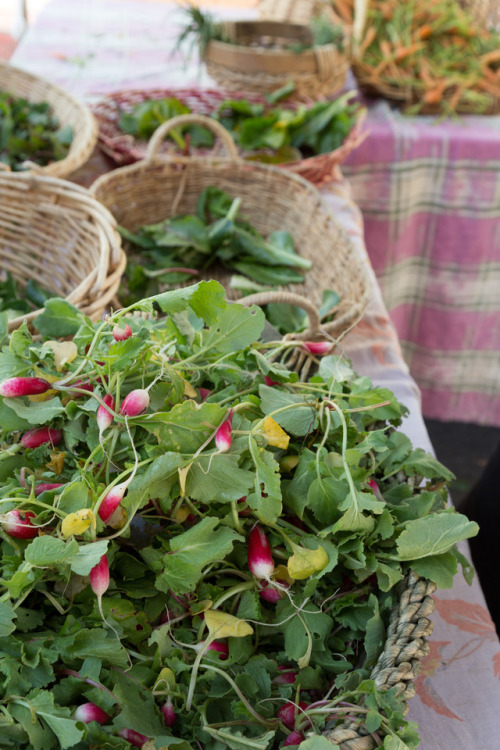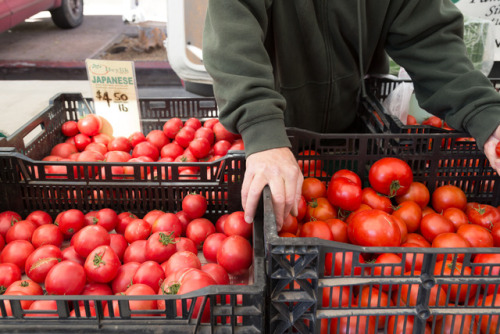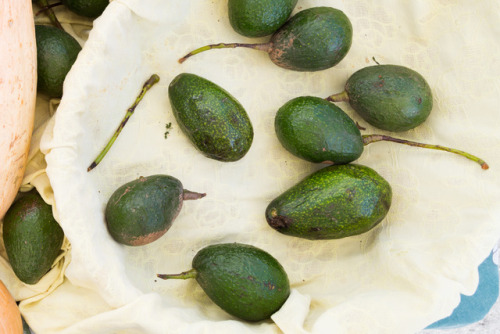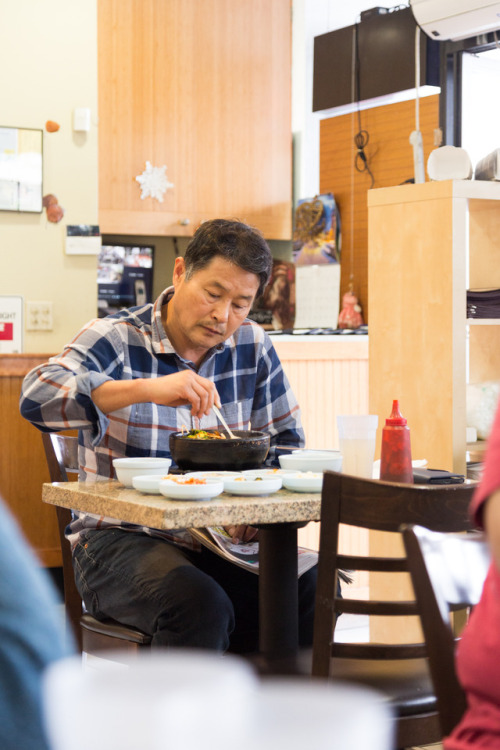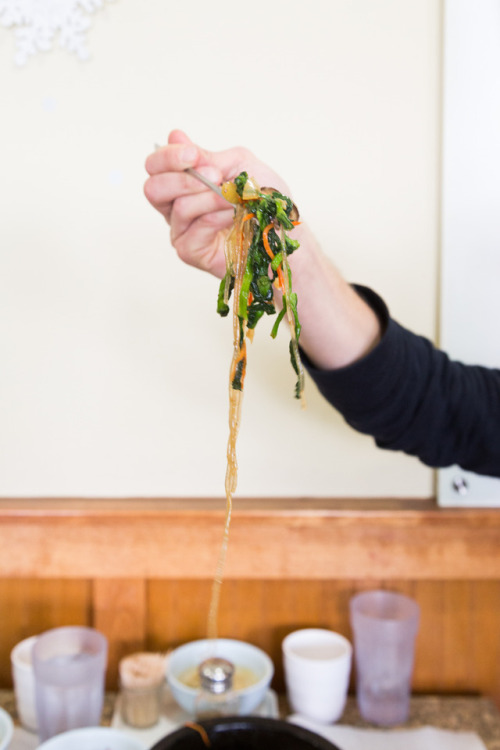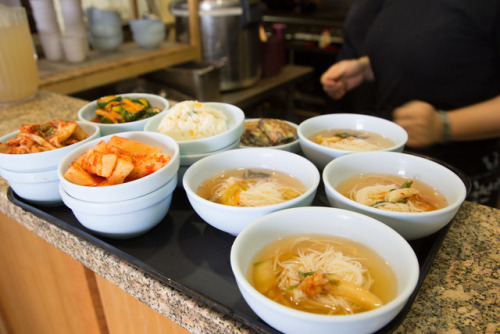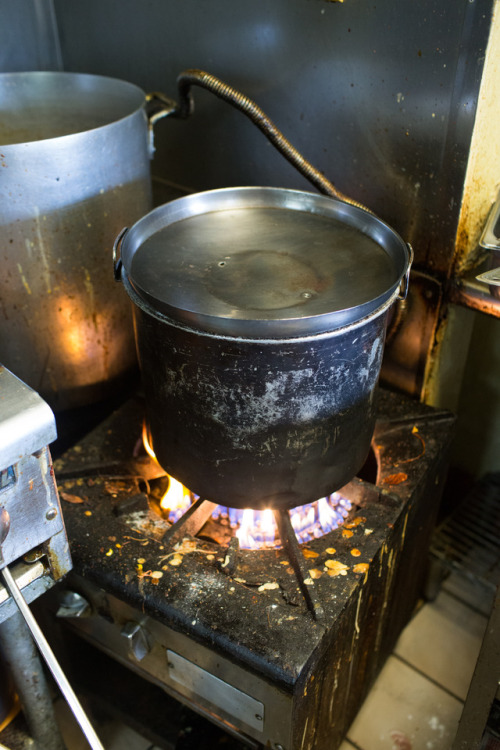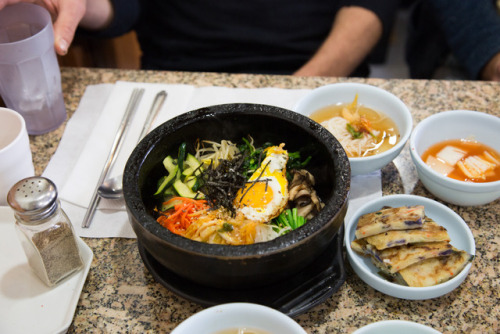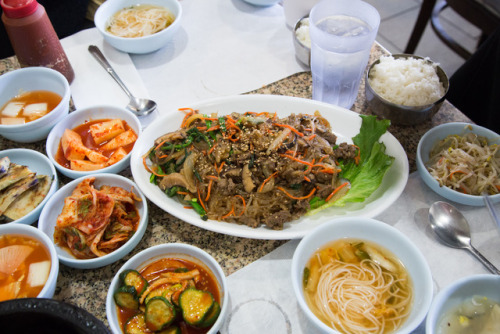#chopttravels
A Parmigiano Steam Bath
Location: Castelnovo Sotto, Italy
While count ourselves amongst the world’s most passionate lovers of the salty, crystalline, cheesy wonder that is Parmesan, we must admit, we didn’t really know much about how it was made until we found ourselves in a dairy steam bath just outside of Parma. Stepping inside Latteria La Grande in Castelnovo Sotto was in instantaneous education. Our trusty guide, Anne, would show us how the cheese is made from milk to wheel.
Latteria La Grande is a coop, where milk from surrounding farms is sent to be made into D.O.P. Parmegiano Regianno. That label is highly protected, and designates that the cheese has come from this very particular area in Northern Italy. We can all conjure the image of the brail-like writing on the rind of a nice hunk of parm, but did you know that was the in effect, the cheese’s birth certificate? It tells those in the know where the milk came from, where the cheese was made, and what grade it received from the Parmesan experts.
The factory is dense with steamy fog, billowing off copper cauldrons of fresh, local milk. Cheesemakers whisk and mix the milk, adding whey to cause the milk to curdle. Those curdle are allowed settle on the bottom of the conical copper vats, into a piece of cheesecloth. The solids are lifted up, a task requiring Olympic strength, already in bound together in one solid form. That form is cut in half with an impressive knife, and then the cheese is pressed into spring form molds. At this point, we just have a soft cheese, but after about a month submerged entirely in a bath of salty brine, the moisture is drawn from the wheel, and it is ready for aging.
Skipping the halls of the Latteria is a pleasure we can only hope you someday come to know for yourself. Rows and rows of delicious cheese from floor to celling, and a scent that actually reminds one more of blue cheese than parmesan. Anne shows us how each wheel is tested after one year of aging, knocking on one with a tiny brass hammer. She listens, perching her ear close to the majestic wheel. She can hear the density of the cheese, how consistent the texture is, and can predict how much time it needs to age. And finally, we have a chance to taste the cheese at its various stages of aging, from one year to three years. We notice the increase in crystals and complexity over time. And of course, we buy a hunk of each one.
Post link
A Visit To A Four Generation Old Acetaia
Location: Modena, Italy
Leonardi Balsamic Vinegar, founded in 1871, is one of the largest producers making D.O.P. balsamic vinegar in the Emilia Romagna region of Northern Italy. When I arrived, it was early Fall, and the Lambrusco and Trebbiano grapes were long gone from the vines. We felt the changing of the seasons, a crucial aspect of the life of vinegar. In Modena, humid, hot summers, great for fermentation, are followed by cold winters, a time when the vinegar cultures get some much needed dormancy. Vinegar is placed in barrels and stored in the attic, windows open to the elements, welcoming that shock in temperature come winter.
Leonardi is a closed loop system – the grapes are grown here, and pressed immediately. Unlike wine, the skins are not used in the making of vinegar, but there are more than enough people in this area willing to take the skins of their hands. The skins are used to make the Italian liquor grappa. Unlike wine, the barrels are never changed out, but passed down to the next generation as a priceless heirloom. The older the barrel the better. As we walk down the dark aisles of mysterious vinegar production, we see labels that reach back to the 17th century. The barrels ooze with sticky black sweetness, arranged in a particular sequence of diminishing size, and varying wood varietals. This set is called a “battery,” and it is definitive of the balsamic process. As the vinegar reduces each year, and is transferred slowly from the largest barrel down to the smallest, to be topped off with fresh grape must from the newest harvest, and bottled at the end of the line.
The process is one that connects generations. A bottle of vinegar will have been started by grandpa, and bottled by grandchild. This is a four generation old business, a living breathing practice that defines this place, and its people.
Post link
Jessica Wang’s Underground Pickle Club
Location: Pasadena, CA
Californians love a good pickle. From the Jewish delis on Fairfax to all the hipster bowls, there is rarely a dish that is served without the pop of a little fermentation or a vinegary brine. As we visited every specialty food shop and salad destination in L.A., we realized we were missing a little hands-on instruction in the realm of fermentation.
I met Jessica while she was behind the register at my favorite Highland Park market, Cookbook. Jessica Wang is a grocer by day and an underground fermentation enthusiast by night. She was trained as a pastry chef, working in restaurants and running her own side business selling homemade hand pies filled with delightful things like fresh coconut meat and homemade guava paste. But all those sweets were taking their toll on her health, so she pivoted to focus on the world of living foods, from home-brewed kombucha to kimchi.
Jessica rang me up for an eclectic selection of kimchis and other pickled delights. Within five minutes of chatting, she’d invited me to her Pasadena kitchen, where I later would taste a rainbow of fermented items stacked like Jenga in her fridge. The smell upon opening her front door was like home. Not my home, per se, but like my fantasy version home. There was a pot of Thai oxtail soup on the stove, chili pods and cardamom simmering on the surface. The contents of the galley kitchen spilled forth into the living room, stacked with vintage cookware from Jessica’s now defunct Etsy shop, and The Art of Fermentation lay open next to her bed.
Working at a specialty food shop with A+ produce means Jessica has unfettered access to ingredients like yuzu (a floral Japanese citrus), and local nori. A friend had recently gifted Jessica a few yacon, a Peruvian root vegetable that pretends to be a potato, but actually tastes more like sweet and crunchy Asian pear. Somehow, even after traveling to Peru twice, I had yet to encounter this mysterious vegetable. Jessica tells me it’s a relative of the Jerusalem artichoke, with a very similar bite but with added sweetness. It’s an Asian pear masquerading as a tuber.
I watched as she turned this trinity of exotic ingredients into a simple ferment. She walked me step-by-step through a process that took no more than 15 minutes. The recipe is a basic one that relies on a formula of 2.5 percent salt to whatever the weight of the vegetable you are fermenting. So, can’t find yacon? No problem! Just grab some Asian pear or jicama, and follow the steps below.
To find out more about Jessica’s underground pickle subscription service and hand pies, contact her at @piquenique_la.
Yacon Yuzu Nori Chili Pickle
INGREDIENTS
920 grams (about 2 pounds) yacon (substitute with jicama, Asian pear or sunchokes)
23 grams sea salt, or 2.5 percent of the weight of yacon
1 yuzu
3 grams natural nori seaweed (or other thin variety of seaweed)
2–3 dried whole red chilies
PREPARATION
Have a clean 1½-quart fermenter jar ready.
Clean yacon and yuzu under running water, with a gentle brush if necessary. Dry with a clean towel.
Cut yacon lengthwise into quarters. Slice thinly crosswise, into ¼-inch thick fans. Use a mandolin if you have one! Toss by hand with salt in a large bowl.
Peel strips of yuzu rind with a vegetable peeler.
Break up seaweed into small bits by hand, or cut into thin slivers with scissors. The volume of seaweed you should end up with is about ¼ cup loosely packed.
Add yuzu peel, seaweed and dried chili to yacon and salt mixture and toss gently, then pack into jar. Put a weight directly on top of the vegetables to submerge them in the brine created by the yacon and sea salt. Seal jar and keep in a dark cool place (around 75°) for 6 days. Taste, and if it’s tart enough to your liking, transfer the pickles to your refrigerator to slow the fermentation and enjoy the crunchy citrusy briny treat.
Post link
The Classic Salads of Los Angeles
Location: Los Angeles, CA
Every year, we venture West on the hunt for inspiration and direction for our favorite destination menu—California. We consider California the birthplace of the “salad as a meal”—a bountiful and colorful one characterized by a parade of texture and flavor. As we take a closer look at the legacy of the city’s most enduring salads, it occurs to us, this is a place where exhibitonism and health food collide. Tossing and chopping have always been treated as a tableside spectacle in this part of the country. While we usually adventure to seek out the newest and most cutting edge in salad land, this time, we embark on a roots trip to uncover the history of the California salad. Let’s take one glance back before venturing forth into the fabulous salads of our time.
I turned to Chopt founder and trusted travel buddy Tony Shure to compose our itinerary. Admittedly, I rarely venture west of Los Feliz, so scanning his list of must-see salads was like embarking on a trip to a foreign land. La Scala, the Beverly Hills Hotel, Lawry’s Prime Rib, the Ivy, and Peppone’s—I had heard rumors of these timeless spots but had yet to uncover the secrets to their enduring success.
Lawry’s Prime Rib
As its name suggests, Lawry’s is a carnivore’s heaven, serving up bloody beef since the 1930s. You know Lawry’s seasoned salt as a household name, but did you know it all began with a special occasion restaurant? Housed in a classic dining room with murals, chandeliers and tableside carts manned by chefs in white jackets and towering toques, salad might be the last thing on your mind when you slide into a puffy leather booth. But wait for your server, dressed in camel-colored uniforms with oversize starched collars and whites, bows in the back, and she will undoubtedly offer you the house salad, served tableside of course. The roughly chopped ingredients are already combined in a metal mixing bowl, set inside another bowl filled with ice. With a flick of the wrist, the bowl is set to spin in a centrifugal whirl. The dressing is added with flair, gravy boat raised high up overhead, drizzling into a vortex of greens. It’s good fun, finished with a mandatory sprinkle of seasoned Lawry’s salt and pepper. Feel free to follow our example, and wash that Lawry’s salad down with a salad pizza from Jon & Vinny’s up the road.
The McCarthy Salad at the Polo Lounge
Of all the Los Angeles tourist destinations, the Beverly Hills Hotel lives up to the hype. The iconic palm frond wallpaper, the pink and white striped awnings, the Teslas and Bentleys parked out front, it’s everything you want it to be and more. Whether or not you choose to foot the hefty price tag for accomodations, the Beverly Hills Hotel Polo Lounge is open to the public. But don’t come looking for a hot deal here, either—their famous McCarthy salad has a $40 price tag!
The salad first appeared on the menu in the 1940s as a tribute to a regular customer, an entertainment lawyer and polo player named Neil McCarthy. By today’s standards, the ingredients seem basic: Beet, egg, bacon, romaine, chicken, tomato, cheddar cheese and avocado. But, it was the groundbreaking presentation that made history. Remember, in Hollywood, presentation is everything. The ingredients are minced into remarkably uniform bits, presented in neat piles in an extra-deep bowl, leaving extra space to dress and toss your salad to your liking in a thick balsamic vinegar, always served on the side.
When it comes to beloved chopped salads, all roads lead to the salad at Beverly Hills’s La Scala restaurant. This is a place to see and be seen, and has been since it was first opened by Jean Leon in 1956. The menu at a place like La Scala doesn’t change, that would defeat the point. Devotees count on their ability to order the very same thing over and over again: The Leon chopped salad with tuna, or just the classic mix of lettuce, salami, mozzarella cheese and marinated garbanzo beans. That’s all fine and delicious, but it’s the Leon dressing, always served on the side, that makes this throwback salad surprisingly cravable. The reason why this dish was originally minced to the point of being spoonable? Leon claims to have been doing his well-dressed Hollywood clientele a service, alleviating their stress around eating unruly greens and splattering their fancy clothes. La Scala still serves about 400 chopped salads a day, although the tuxedos and ball gowns are few and far between.
Peppone’s
Los Angeles loves a red sauce joint. Red leather upholstery, stained glass lamps, heavy wooden bars and servers with old-world charm. Putting out feelers for just the right dimly lit booth for dinner, we were tipped off to a place called Peppone’s in Brentwood. This is the kind of place where the waiters have been working there for longer than I have been alive. Peppone’s has stayed true to the tableside presentation of salads past, but unlike Lawry’s, this continues to serve as a real neighborhood joint, not a once in a lifetime salad experience. Peppone’s attracts and keeps its regulars, people looking for comfort food, cozy seating and a bartender who knows their name.
The menu is full of chopped salads, but all of them seem to shuffle the same core ingredients in a slight variation. Once again, we were greeted with a cart full of greenery and dressings, the ingredients tossed with flair. We were sad to learn that the tableside Caesar dressing came premade, but apparently, health codes had made it impossible for them to legally handle raw egg in the restaurant dining room. Sad as that was, a big martini and a hefty plate of salad did not disappoint.
Post link
The Secret to Mister Jiu’s Char Siu BBQ Pork
Location: San Francisco
Mr. Jiu’s is not your typical Chinese restaurant. Walking down the streets of San Francisco’s Chinatown, you can’t pass by the giant picture window with a view of the buzzing pastry kitchen without poking your head (and nose) inside. As I roll up, the sight of black squid ink dumplings being pinched and the restaurant’s famous char siu pork buns getting filled with bright-red seasoned pork belly beckon me in. Inside, pastry chef Melissa Chou is reimagining the very image of what a Chinese pastry can be. She tells me, “I constantly google ‘Chinese desserts,’ in the hopes that I will find something new, but there really isn’t much. That gives me a lot of freedom.” This place would be nothing without precisely that freedom, an experimental ethos that drives both Melissa and executive chef Brandon Jew (aka Mr. Jiu).
The two met in the kitchen at nearby Quince, where the chef often teased Brandon by saying he would one day open a “Chitalian” restaurant. Drawing from his Chinese heritage and experience cooking in Bolognese kitchens, he pretty much went ahead and did just that—and it really, really works. But neither Brandon nor Melissa grew up cooking their ancestral cuisine. Brandon tells me, “When you immerse yourself into a cuisine, you’re learning cultural traditions, why people have paired certain ingredients together for as long as they have. At some point, I just wanted to know those same things in my own culture. That curiosity propelled me to go to Shanghai.” Mr. Jiu’s is the result of a respect and fascination for traditional Chinese food but with a healthy distance. This relationship extends beyond the plate and into the dining room decor: The sleek, modern design interior is punctuated by the original lotus flower chandeliers that adorned the former Chinese banquet hall, rehabilitated and brought back to life. It’s a touch that seems to say it all.
Back in the kitchen, we are here to learn how the famous Mr. Jiu’s char siu is made. There is no denying that this is the best version of the dish in town, it’s their top seller, “since forever,” says pastry sous-chef Kelly Teramoto. Char siu is a traditional Cantonese dish of red glazed barbecued pork, most commonly served in pork buns or with egg noodles. But why is it red? And how do they achieve that addictive flavor? Brandon sets a jar of his secret sauce on the counter, giving it all away in an instant: Red rice inoculated with koji and fermented tofu. It’s a product he picked up in Taiwan, but one he hopes to start to make in-house. This is where the sweet and salty flavor comes from, and most of the color, too, though sadly, the average char siu is augmented with red food dye. Not here though—Brandon adds beet to the mix, for a natural magenta hue.
With the char siu filling holding down the traditional end of the spectrum, Melissa would add a signature twist. She recalls a very special pork bun she ate in Hong Kong, one with a mysterious crunchy topping. It reminds her of the classic San Francisco “Dutch crunch,” a sweet crispy layer found on the city’s most coveted sandwich breads. A salad eater more than a sandwich eater, I had never heard of this technique for adding a layer of sweet and texture to crust, but a quick scan of the Internet reveals the reverence that this city has for this technique.
I watch as Melissa rolls rice flour paste wafer thin. She tucks some savory pork floss right into the Dutch crunch, adding flavor and additional color to the mix. She pops it in the freezer to set, slices it into squares, anointing the little buns with one square each.
In the heat of the oven, the topping melts and crystallizes. We slice one open, steam spills out of the doughy interior cavity, where that char siu is cooked to perfection.
Post link
The Zuni Cafe Caesar Salad
Location: San Francisco, CA
Take it from the experts: not all Caesars are created equal. We take a particular pleasure in finding the very best when it comes to inspiration. While our Spicy Sonoma Caesar is an innovation on what is arguably the world’s favorite salad, we wanted to revisit the platonic ideal of what is for us, a sacred dish – the Caesar at San Francisco’s Zuni Cafe. The culinary world has considered this the very best example of a Caesar since the early ‘80s. It was one of three items on the menu when they opened in 1979, and it continues to be a best-seller.
Snooping in Zuni’s open, sunny kitchen, we got an inside look at the flicks of the wrist and the pinch-of-this-and-dash-of-that that make this salad an all-star. The set up is the best part. Metal mixing bowls hang from the ceiling at arm’s length. The saladière mixes a rich, anchovy based dressing in a stainless steel mixing bowl, frothing it up with a whisk. Crunchy, perfectly shaped romaine spears are added and tossed with a delicate hand until they glisten. A handful of evenly browned and uniform croutons are added to a smaller metal bowl, bathed in their own scoop of the same dressing, and left to sit for as long as it takes to plate the romaine, which happens to be the exact right amount of time for the crumb to soften and the flavor to permeate, without a hint of mushiness. The Lettuce is seasoned with fresh black pepper and kosher salt, and slid over onto the plate. The croutons are added, and fresh parmesan grated delicately on top. Keep your eye on the kitchen, and you’ll notice, the salad station never stops. One after another, they keep coming all day and all night, forevermore.
Post link
Tra Que Organic Farm
Location: Hoi An, Vietnam
By Chopt Creative Director Julia Sherman
I like to describe my own gardening style as rogue, improvised, carefree. Historically, I have taken great pride in that loosey-goosey approach, that was before I visited the Tra Que organic farms outside of Hoi An.
Tra Que is a small farming community village 3km north of Hoi An’s Old Town. The village cultivates over 20 different varieties of herbs alone including basil, knotweed, Vietnamese mint, coriander, perilla, rau ram and more. Those piles of fresh herbs that are served with every meal have to come from somewhere! The scientifically placed rows of chives, herbs and mystery salad greens are so meticulously arranged, it’s hard to imagine they were put there by human hands, using organic farming techniques, no less.
Touring by bike, we cruised through the succession of thriving plots, strategically built between the De Vong River and the Tra Que alga pond. This specific location creates especially rich soil and great access to water. The farmers don’t use chemical or fertilizers, instead they source algae from the lagoon, taking great pride in their completely organic and safe farming techniques. Tourists can sign up for organized tours of the farm, and even take cooking classes at the nearby Watermill restaurant, or, just rent a bike and cruise on through.
Post link
Rose: Dumplings: The Street Food Of Your Dreams
Location: Hoi An, Vietnam
We did it. We found the perfect street food.
There is a dumpling that far surpasses all the rest. It is chewy, and light, fragrant and bit-sized. It is the Vietnamese rose dumpling, made with chewy tapioca and rice noodle skin, filled with shrimp or fresh bean paste. They are topped with toasted crispy garlic and served with a dipping sauce made from flavorful shrimp broth, hot chilies, lemon, and sugar. They are so elegant, it’s hard to imagine they are being served on the street corner fora dollar a serving.
In the open air markets of central Vietnam, dense clusters of women squat on low stools, singularly focused on the tiny bowls cradled in their palms. Look for a large metal pot in the center of these parties, that’s always a good sign. And try them all, each vendor we patronized had their twist, their own variation on the filling, the chile sauce, even the shape of the dumplings themselves. It’s a wonderful world out there, start eating!
Post link
Spear Fishing off the Coast of Vietnam
Location: Phu Quoc, Vietnam
There are a few activities in this world that I really feel I was born to do, but uni spear-fishing is one of them. On my recent trip to the Vietnamese island of Phu Quoc with Chopt’s Executive Chef Aneesha Hargrave, we had the chance to realize our full potential in the hunter-gatherer realm. Using nothing more than a long wooden stick with a crude metal spike fastened to its tip, we set out to fill our dingy with as many spiny crustaceans as it would hold.
Compared to traditional line fishing, uni hunting is a breeze; if you can swim, glory in the the open water is yours for the taking. Cuong Pham, the owner of Red Boat Fish Sauce, served as our trusty captain, along with a couple of his childhood buddies who came along for the ride. These guys were no strangers to this kind of lo-fi, high-reward adventure. We zipped out into the bay, whose depths were surprisingly shallow and crystal clear – perfect for the task at hand. Following their lead, I suctioned my goggles to my face, stuffed my feet into a set of rubber flippers, and descended into the perfectly temperate waters. These lazy living pincushions move very, very slowly along the ocean floor, so if you spot one lurking in the shadows of a coral formation, it’s yours. Wielding a spear that is less Poseidon more enormous fish fork, we bobbed above our prey, plunging metal prongs into the center of each shell. I must have caught 30 of them myself.
As the sun began to set, we returned to shore to prepare and enjoy our catch. With thick rubber gloves as armor, we watched as our hosts trimmed the spines with rugged shears, cracking the shells to reveal delicate little orange gonads. Yes, the coveted, orange uni flesh is nothing more than the animal’s reproductive system, but I suppose it’s best not to dwell on that. They popped open the shells and laid them open-faced onto a smoldering charcoal grill. Once cooked, we drizzled a bit of fish sauce inside, and administered a healthy garnish of crushed peanuts, fish sauce and freshly sliced green onion to each one. Catch it yourself, and it just tastes better. We’re not afraid to adventure for our food, and work for it either.
Post link
Love for the Single Dish Restaurant: Focus, Efficiency, and Insanely Delicious Food
Location: Danang, Vietnam
While exploring the central coast of Vietnam, we ate our way through the small town of Danang and its surrounding area. This region of Vietnam is packed with our very favorite type of restaurant: the kind that only serves one dish. There’s focus here, whether it’s at a food cart selling bánh mì or a restaurant serving up bowl after bowl of pho, when a restaurant only offers one dish, they tend to do it right. We lingered at the cart that just shredded, chopped and served coconut meat, and encamped with the lady selling delicate “rose” dumplings from a mobile steamer. But our absolute favorites were spots for Hainan chicken and rice, a typical lunch, and a back-alley dining hall serving crispy banh xeo, made on what can only be described as a ring of fire.
The restaurants in Hoi An are jewel-box-sized and often painted in vibrant colors, amplified by the light from bare fluorescent bulbs. We are on a mission to lunch like locals, trying to move through the tourist crowd in this riverside town. We see a Vietnamese groom and his red satin bedecked bride duck into a turquoise room advertising “Cao Lau,” or “Hainan Chicken and Rice,” the dish we are after. Naturally, we follow suit. The place was simply called Cao Lau PHÚC, and the kitchen is indistinguishable from the dining room, which seems to flow into a bedroom just barely hidden from view. Sitting amid the large plastic bowls of the mise en place, the chef could hardly pick herbs fast enough to meet the demand—always a good sign.
This dish originally hails from the Hainan islands off the coast of China, brought to Singapore and Vietnam by immigrants. The recipes and variations multiplied with the diaspora, but the defining feature of Hainan chicken and rice remains the same: The chicken is poached, and its broth and rendered fat are used to cook the rice. Sometimes, the leftover stock from one batch is used to poach the next chicken, concentrating the flavor over and over again. The broth is served on the side, with a few aromatics tossed in. The chicken is cut-up, skin and all, tossed with sliced white onion and herbs, and served beside that flavorful rice. With a little pile of shredded green papaya on the side and a side of chile sauce, you’ve got a meal worthy of your wedding day.
From Hoi An we head to Danang to find the crispy rice crepe of a lifetime. The drive begins with charm and cobblestone streets, but soon the setting morphs into flashy casinos and nightclubs that seem as though they sprang from the ground overnight. Deeper into the heart of Danang, smaller, squirrely streets house some of the best food in the country. Tonight’s reward lies at the end of an alley crammed with stalls selling packaged beef and pork jerky shredded, flossed and in flat sheets—some sweet, some salty, some covered in a thick layer of chile, some made for snacking and others for adding to soups and salads. We stumble upon a sign that reads “Bánh Xèo Bà Dưỡng,” filled with families and tables of young people drinking beer, all eating the very same thing: banh xeo, a rice flour crepe, filled with seafood and bean sprouts.
At Bánh Xèo Bà Dưỡng, there is no menu. Claim a plastic stool at one of the stainless steel work tables throughout the stark bright space and food comes shuttling toward you, piled high on trays. First, a plate with some kind of beef and pork kabob, a mountain of herbs, shredded papaya salad. Dry, almost plasticy rice paper wrappers and a bowl of water follow suite. We take a queue from our neighbors and re-hydrate them one at a time to make our own delicate fresh rolls. The banh xeo comes next, crispy on the edges, yellow from just a dash of turmeric. It’s piping hot.
The open kitchen is in a tizzy, with slicing, dicing, plating and drama. A horseshoe-shaped stovetop encircles a crew of women, heads wrapped in bandanas, pouring batter into molded cast-iron banh xeo pans. Flames flare up every time they approach with a ladle full of rice batter speckled with seafood. It’s sensational and theatrical, and it’s hard to imagine the stamina required to do this all night long. The meal, paired with ice cold Vietnamese beer, is a generous balance of herbs and fresh veggies, charred meat and those decadent crepes. The kitchen hums in the background, and customers beam as they get exactly what they came for, making a communal activity out of crafting the perfect bite, over and over again. Sitting at industrial tables, there is an unspoken sense of camaraderie in knowing that everyone around you is eating the same exact meal. This is a restaurateurs dream, an operation that promises to deliver the very best version of their namesake dish, day after day, to a constant flow of happy, well fed customers (myself included).
Post link
Fish Sauce: The Heart of Vietnamese Cuisine
Location: Phu Quoc, Vietnam
If you love Southeast Asian food, you most likely know the wonders of fish sauce. It’s the umami-packed, savory heart of most dressings and sauces in that part of the world. Whether it is immediately detectable to the consumer or not, it’s the secret ingredient that defines the best Vietnamese dishes. When we found out that the location where most fish sauce is made is a tropical island with stunning beaches and bountiful open-air markets, it suddenly became critical that we go to the source. In preparation for a round of Vietnamese destination specials, Chopt’s chef Aneesha Hargrave, illustrator extraordinaire Joana Avillez and I flew 20-plus hours to the island of Phu Quoc to visit our friends at Red Boat fish sauce and get a handle on their stinky, delicious production.
Google the island of Phu Quoc and the image results define your notion of paradise: white sand, bright blue water, palm trees—the whole kit and kaboodle. The island is so far south and remote, the tourist industry is only just beginning to burgeon, with resorts dotted along the coastline, some with beach shacks, and others taking design inspiration from Disneyland. Fishing has always been the leading industry here, specifically black anchovies used to make fish sauce and it’s Chopt’s source for fish sauce in all our restaurants.
Turquoise and red wooden boats sail four hours out into the sea by moonlight, finally anchoring in the wee hours of the morning. They release a net into the water and haul tons (literally) of anchovies onto the deck of the boat. Chef Aneesha went along for the grueling, all-night adventure, without so much as a place to rest or sit on board. She captured swarms of metallic, glimmering fish dramatically lit by floodlights in the pitch black night and experienced the rush to toss them with sea salt and preserve their peak freshness on the long trip back to shore.
Once at the factory, we got the play-by-play from Red Boat’s founder, Cuong Pham. The process is reassuringly straightforward: 14 tons of the heavily salted fish are transferred to traditional wooden barrels, which are 10 feet tall and outfitted with a spout at the bottom. Each one produces 3,000 litres of fish sauce. They are simply left to ferment for a year, ultimately turning to liquid. The heavy salting encourages the process of lactic acid fermentation, and results in a light brown, tasty liquid that is clean and clear, the color of an amber brewed tea. It’s as simple as that, no preservatives or additives necessary, the same recipe for centuries past, and—hopefully—generations to come.
Post link
Making Mole in Oaxaca Is About More Than the Sauce Itself
Location: Oaxaca City, Mexico
At Chopt, we tend to prize maniacal focus over any other quality in a chef. To understand the endurance and commitment it takes to prepare a dish as complex as molé, you have to make it yourself. It has many variations, from coloradito with a plantain base, to the more common negro, with the distinctive bitterness of cacao. But you can’t just show up in Oaxaca and make molé. You have to learn from a maestro, and we found one in Soledad Martinez. Martinez doesn’t have a recipe to share, or a cookbook to refer you to. To unlock the magic of her molé, you have to chase her through the open air market, collect the ingredients one by one, build a fire on her stone patio, char fresh peppers and tomatoes, and toast and grind the spices. There is even a soup to prepare and eat in anticipation of the molé itself. A pre-game ritual to quell impatient travelers in face of the task ahead. Molé is in itself, an act of cultural immersion that ends in a meal.
For Martinez, cooking is survival. She was raised by her mother, who made her living selling homemade tortillas in a small village called Ejutla. She didn’t just sell tortillas but woke at 4 a.m. to nixtamlize and grind the corn, to form them by hand, and travel by foot to sell them door to door. No matter how excellent the tortillas, they alone were not enough to support the family. When Martinez was just 6 years old, she went to live and work as a housekeeper in a wealthy home. There, she gravitated toward the kitchen, and before long, she was shadowing the cook and learning hands-on how to make traditional Mexican food from scratch.
By the time she was 18, Martinez had a lifetime of experience with Mexican home cooking and was able to open her own restaurant. This was a huge accomplishment in and of itself, but she never could have imagined what came next. The director of the Oaxacan Institute of Culture approached her and asked her to teach cooking classes to chefs visiting from abroad. She had never attended school herself, but she was called upon to share her life’s work with 14 international chefs a day, hosting them in the intimacy of her own home.
Like so many students before me, I met Martinez at the central market in Oaxaca City. She is no more than five feet tall, with short cropped hair and eyes that are always smiling. We were there to collect the laundry list of essential ingredients for molé poblano and the fortifying soup we would eat before we even started cooking our main dish. The soup was called sopa de guias. It’s an ode to the cute-as-a-button round squash, calabacitas, made with everything from its gnarly vine to its bright yellow blossoms. It’s simply simmered in water with garlic, onion, fresh corn and finished with chepil, a green herb that tastes faintly of green beans. We formed masa dumplings in the crooks of our palms, pressing a thumb into their centers to form a dimple, and setting them to poach in the clean, clear broth. It was meant to tide us over for the long haul ahead.
Martinez’s mole is built on a foundation of red ancho chiles, the less common called chircosle chile (it’s worth stocking up on these if you can find them, but the more readily available guajillo are a close substitute). Toasting the chiles in a dry skillet awakens their aroma and depth. Once they are toasty but not burnt, Martinez splits them open lengthwise to remove the seeds. She’s after the flavor of the chile, not the heat.
Fresh tomatoes, onions and garlic are roasted over hot coals until their skins are black, dusty with ash and easily slipped away. We blend them with toasted sesame seeds, cinnamon stick, oregano, thyme, cloves and almonds. Martinez throws minced fresh ginger and garlic in a pan with some lard, sautéeing them quickly, and adds that to the mix. Then the most surprising part: We toast black raisins and some bread, which are added to mole to sweeten and thicken. We watch as all these ingredients combine and deepen, forming a fragrant stew.
Finally, chicken is set to bathe in the rusty red sauce, while we flatten balls of masa in the hand-press and set our homemade tortillas on the comal to cook. It’s been eight hours (and a few mezcals) since we first convened. Maybe that’s a long time to make a single dish, but it’s never really about the food, is it?
Post link
The Original Caesar Salad
Location: Tijuana, Mexico
So, you thought Chopt invented the Mexican Caesar, prepared à la minute, right in front of your very eyes? In fact, the classic Caesar was born in Tijuana, prepared table side with taste and flair, far before we started riffing on the recipe. It was the twenties and prohibition was in full-effect. Tijuana was not the seedy town it is today – it was a Hollywood destination for two of our favorite things, booze and salad innovation. The details of the inception of the Caesar salad are hotly debated to this day, but their birthplace is not: Caesar’s hotel and restaurant on the for the once glamorous Avenida Revolución. I traveled there last winter to experience table side Caesar that made salad history.
In the middle of the street filled with head shops and bars, a classy outdoor patio still beckons with smartly dressed waiters circulating carts piled high with savory ingredients, spears of crisp lettuce, and well-oiled wooden bowls. Sure, there are other things on the menu besides salad, but everyone here is after the same thing. Dressing is made directly in the salad bowl, the lettuce is gently dressed, and guests watch with mouths agape as parmesan rains. Salad is served and does not disappoint.
For more than 50 years, diners have flocked to Caesar’s for their eponymous salad, but the progenitor of the dish remains contested. The controversy surrounds Caesar and Alex Cardini, a pair of brothers who first immigrated from Italy to San Diego, and opened their first restaurant. When prohibition came into effect, they realized the real money to be made was in a lawless border town called Tijuana. So they opened Caesar’s Hotel and Restaurant to cash in on the scene. This much we know, but from here, the story gets murky.
If you had invented the world’s favorite salad, you’d want credit for it too. Both brothers laid claim to the salad, and there’s a third rumor that the recipe originated with a dishwasher named Livio Santini, who may or may not have innocently shared his Italian mother’s recipe with the kitchen. But Caesar Cardini’s salad myth starts with a packed house and an act of culinary desperation. It was the summer of 1924 and American were guests eating a drinking their way through the last of the kitchen supplies. He claimed to have thrown together the last of the remaining staples from the larder to make a dressing – olive oil, raw egg yolk, Dijon, parmesan cheese and Worcestershire sauce. He tossed some romaine in the bowl and served the spears to be eaten as finger food (the original hand salad). The dish was a hit, and so he made it his namesake and watched as the word spread around the world.
You might have noticed the absence of arguably the most important ingredient in that very first Caesar – anchovy. Anchovies emerge as the hero in Alex Cardini’s version of the tale. He was a pilot in Italy’s air force during WWII, and claims to have invented the salad when a group from the American Airforce men made their way down to TJ and into Caesars one night, looking for a good time. He threw together a salad with all the ingredients mentioned in Caesar’s tale, plus anchovies. He named it the “Aviator Salad.” But soon, Alex moved to Mexico City to open his own restaurant, and Caesar slapped his name on the dish and stole his brother’s glory.
So, the Caesar salad we have all come to love might actually be an “Aviator Salad,” Italian in flavor but born in Mexico. In our opinion, it’s a dish ripe for reinvention.
Post link
El Pizon Uni Tostadas
Location: Ensenada, Mexico
Ensenada is not your typical beach town. It’s less postcard images of pristine beaches, and more urban coastline, with car repair shops, junkyards, mega supermarkets and a congested tourist center. Here, you can find all the leather Bud Light beer can holsters, Mexican jumping beans, sombreros and a slew of “American Pharmacies” selling viagra and valium over the counter. But if it’s street food you’re after, the city is a major port and the possibly the only place where I would eat raw seafood from a street cart for three meals a day. Even the cheapest tostada stand is shucking oysters, clams and fresh scallops to order, charging only a couple bucks for what we consider a rarified delicacy just North of the border.
The best example of this kind of briny indulgence can be found on the outskirts of town, on the corner of a dusty gas station at El Pizón. You can find the owner, Alan, setting up his cart sometime between 10am and noon on any given day, unloading his collection of hot sauces and cutting boards so worn down, they look like topographic maps of Mexico. He rolls his cooler full of fresh sea urchin from the flatbed right onto the street, and it’s game-on. Characters come out of the woodwork – it’s like Alan sent it tostada bat signal out into the universe, and the universe responded. $10 miracle of freshly caught sea urchin seasoned with homemade pico de gallo, cilantro, lime juice and black pepper. This mish-mash is gently stirred to combine all the flavors, then served with tostadas and a side of ranchera music blasting from his impressive sound system. Once seated, Alan proffers up a magazine, frayed edges, the cover’s color faded from the sun to nearly a monochrome cyan, and proudly flips to his portrait, positioned amidst a story on the region’s best chefs.
Alan himself is no minor character in this dining experience; storytelling is part-and-parcel of ordering his proprietary uni platter. To serve uni this fresh, you have to have a hook-up. Once an uni diver himself, the business is a family tradition. The portion we scooped up onto our fresh corn tostadas that day was caught by his sister, who keeps that side of the family business afloat, collecting uni from Baja waters and delivering them to Alan every morning. Alan has traveled as far as Japan with his Uni, selling Mexican product at the famous Tsukiji market. But these days, he stays close to home, receiving a steady trickle of loyal guests and the occasional tourist, looking for the best deal in town: a plate of the most coveted product of the sea, served in the most casual way, “blessed” with a few drops of olive oil.
Post link
Restaurante Laja and Roadside Carnitas
Location: Baja, Mexico
I didn’t realize it at the time, but my first hour in Baja would come to represent much of my unfolding trip. I drove across the border at Tijuana, and within an hour, I had arrived at the pin on my map where Bichi vineyards were purported to be, but alas, there was no sign of an entrance. Of course, cell service had long since vanished. Massive trucks zoomed by, making every U-turn more unnerving than the last. Just as I was contemplating crossing back into California with my tail between my legs, Noel, the co-owner of the winery, came flying in to show me down the camouflaged road. “Was it so difficult to find?” he asked. When I looked at him incredulously, he replied, “Good.” In this part of Mexico, the best things are hidden in plain sight.
I arrived at Bichi, Baja’s only natural winery, in the midst of a vineyard staff Christmas party. I was meeting up with my friend, chef and mezcal producer Niki Nakazawa, who had just finished touring the country’s best palanqués (mezcal facilities) with the team from Noma Mexico. I found her seated at a long table at the base of the vines, surrounded by the families who make this operation tick. They were drinking the funkiest organic wines and reheating Domino’s pizza over a wood-burning stove. Isn’t this exactly the way beautiful wine should be consumed? The bottles Noel was pouring were made in collaboration with his mother and brother, chef Jair Téllez, who was off in Mexico City running his award-winning restaurant, MeroToro.
Bichi has been enjoying a moment of recognition, as the U.S. consumer warms up to the more complex, unpredictable palate of naturally produced wines. While American wine lovers are just getting hip to the idea that there is indeed a vibrant wine region south of the border, for the Téllez family, Ensenada has always been the gustatory capital of the world. They were born and raised here, and this is where Jair made his mark in the restaurant industry with Laja, Mexico’s first farm-to-table restaurant, located just an hour south of the winery. That would be our next stop.
Housed in a stand-alone Spanish-style hacienda, the restaurant is surrounded by sprawling organic gardens that provide 100 percent of the produce for the kitchen. There is nothing of this sort for many miles, so anyone who has eaten here has made the journey for that reason alone. After spending the day with Laja’s chef Rafa Magaña and his brother Maro Magaña, the restaurant’s organic gardener, I got the sense that this remove was, again, very intentional. For the people who work here, this is a way of life, a family and a mission, rather than a means to food-world stardom or notoriety.
I wanted to taste their famous food and visit the grounds where they grow nearly every ingredient we ate that day. What I didn’t expect was the marathon of cookery and culinary backflips that ensued. First, we picked the veggies with Maro under misty skies — monster parsnips, beets and bushels of salad greens that were even more vibrant against the gray of the day.
Back in the kitchen, Rafa was already scheming, enlisting his full staff to create a rolling meal for two. I watched closely and tried to take notes as he diced parsnip and browned it, picked herbs and gingerly prepared the most tender baby vegetables. I was ready to eat standing up in the kitchen, but Rafa wanted us to have the full experience and sent us into the dining room. When the waiter arrived, those parsnips had been transformed into a silky parsnip purée, spread over a crunchy seaweed based tostada, topped with a quick stir fry of fresh, thinly cut veggies. I would have happily made that my meal, but this was only the first course.
Having devoured the most delicious tostada of my entire life (and I have eaten a lot of tostadas), I expected Rafa to pack up. I was very, very wrong — we were in it for the long haul. There was a salad of baby lettuces and butter-poached Japanese turnips. There was fish caught that morning, perfectly seared, served with the simplest presentation of charred garden vegetables. My personal favorite, a dish I still think about regularly, was poached eggplant in tomato jus, topped with fennel fronds and microgreens.
Hours (and countless glasses of wine) later, Rafa finally hung up his apron and joined us. When he first showed up at Laja looking for a job, he was just a kid looking for menial job to pay the bills. Back then, Jair was the chef de cuisine. While Rafa is quick to attribute everything he knows to Jair, he clearly has an intuition all his own. He rose from kitchen assistant to sous chef, and eventually chef de cuisine when Jair went on to Mexico City to open his next enterprise. There were no recipes involved in Rafa’s culinary education because he never learned to read or write. Instead, he learned by trusting his senses — watching, tasting and smelling. We were witness to his laser beam focus. There was no script required.
When it all seemed to be coming to an end, Maro must have seen our faces drop. He was quick to up the ante with the next adventure. “Te quiero carnitas?” he asked. Clearly a rhetorical question, he handed us a piece of scrap paper with a handwritten map and an X at the anonymous intersection where we were to meet him at 2 a.m. We were going to see the other side of the family business, a roadside carnitas stand passed down to Maro from his father who had perfected the art for 12 years before him. Fine dining might be relatively new to the Magaña family, but Maro tells me, “My father taught us how to make birría, carnitas, barbacoa, consume, menudo — traditional Mexican food. Food that people like.”
Post link
Cochon Butcher
Location: New Orleans, LA
Chopt’s co-founder Tony Shure travels the globe, making sense of a new city, it’s casual fare, its most savory and satisfying offerings through its best sandwiches. That’s right. He has staked his professional life on salad, but sandwiches are how he moves through the world. Luckily, New Orleans is a sandwich town, from Po’ Boys to BBQ, meat and bread are a religious endeavor.
Cochon Butcher is a butcher shop, wine and sandwich bar, in the warehouse district of New Orleans. Pulled pork with creamy coleslaw are served beside the world’s crispiest bread and butter pickles (seriously, we would kill to know their secret). Tourists and locals alike, queue up as early as 11am to get a taste of James Beard Award-winning chefs Donald Link and Stephen Stryjewski’s house-made charcuterie, muffaletta, and oooohhhhh, that pastrami sandwich!
Post link
Arnaud’s French 75 Bar
Location: New Orleans, LA
Your first stop in New Orleans might not include a salad…But that should come as no surprise. To get a taste of this town, you have to have to dip your toes in the cocktail scene, and start out at Arnaud’s French 75 Bar, a classy local favorite in the heart of the French Quarter. This place is a stalwart in Southern charm, with the waiters, some of them having worked there for 30 years or more, attending every detail of your experience and dressed to the nines. Sidle up to the bar and order their signature cocktail, the French 75, which is made with champagne, lemon juice, gin, and a dash of simple syrup. If you are a whiskey lover, get down with their Sazerac, named for the Sazerac de Forge et Fils brand of cognac brandy that served as its original main ingredient.
At some point a little birdie will whisper in your ear, that there is more to see than what meets the eye. The second floor houses the Germaine Cazenave Wells Mardi Gras Museum. This sweet, intimate museum presents Ms. Wells’ personal collection of her family’s Mardi Gras costumes, dating from 1941-1968. Just one spin around this opulent costume exhibit, and you will understand the importance of Mardi Gras in the New Orleans culture.
Post link
BARE Olive Oil
Location: Portugal
In the salad game, excellent olive oil is the holy grail. Sure, the shelves are packed with consumer options, but like wine, oil is complex, and speaks volumes about the the people who make it and the land from which it came. But, unlike wine, olive oil does not improve with age, so Chopt Founder, Tony Shure, traveled to Abrantes, Portugal to procure this year’s newest harvest of olive oil from a small producer called BARE. Like…we are are trying to tell you, he went to visit the olive farm, and bought-up every last drop of the oil they produced this season for all of our Chopt locations. That’s a baller salad move.
You might be wondering: why Portugal? Why BARE? The Portuguese consume 85% of the world’s extra virgin olive oil, so they know a thing or two about the subject. BARE’s owner, Rui Abecassis, also the producer of our favorite vino verde, Obrigado Vinhos, explained to Tony that the smaller the production, the better the oil. His olives are hand-harvested, and non-irrigated, meaning they are pampered from day one by actual people, as opposed to machines. The madural, verdeal, and cobrancosa varietals of olives are pressed within hours of the harvest, and kept at a cold temperature. This keeps the oil fresh and clean, and is the reason why it comes out kryptonite green in color. This level of care ensures that our oil maintains its intense grassy flavor for longer than the mass-produced oils. Go taste it for yourself: BARE extra virgin olive oil is now featured in every Chopt locations.
Post link
Santa Monica Farmers Market
Location: Santa Monica, CA
Nothing compares to the California farmer’s markets. From the sea creatures to root veggies, every single item feels staged for the camera, too perfect to be real. We stopped by the famous Santa Monica Farmer’s Market to check out what they had going on, and filled our trunk with California avocados, baby radishes (with their tender greens!), and one of our favorite local products, California dates. They are stickier, sweeter than any off the shelf product you can find. We milled about enjoying a free sample or two, scoping the purchases of so many renowned local chefs. This is their market of choice, so you can get a nice preview of what’s coming up on the menu, anywhere from Kismet to Fishing with Dynamite.
Vegetable tourism…Is that a thing? It is now!
Post link
The Best Bibimbap in LA? We’ve gotcha.
Location: Los Angeles, CA
It’s no surprise that we are crazy for Korean food: It’s fermented, it’s spicy, and it‘s packed with bold flavor. While Korean cuisine is certainly not known for its salads, one could make an argument that a typical Korean meal does indeed start with a salad bar on every table. We’re talking about banchan, the infinite array of tiny side dish/salad-y things that descend upon your table before you even order. There’s nothing more enjoyable than a table covered in tasty veggies, and the best part is, they just come to you automatically!
Of course, Los Angeles is known as an epicenter of Korean food in America, so we had to do what any self-respecting food tourist would do, and hunt for the best bibimbop in town. We found ourselves at Jeon Ju, a perfect strip mall hole-in-the-wall with some serious home cooking going down in a railroad kitchen. We snuck back there to see what was on the stove, and found sizzling, bubbling stone pots, soups and sauces. And the bibimbop? Perfectly crunchy on the bottom, crunchy with pickled veggies and rich with fried egg.
Post link

